Business & the Business Environment
VerifiedAdded on 2023/01/13
|20
|6473
|72
AI Summary
This report focuses on different types of organizations, their size and scope, and various functions within an organization. It also discusses the impact of macro environment factors on business operations and the interrelation of company's strengths and weaknesses with external factors.
Contribute Materials
Your contribution can guide someone’s learning journey. Share your
documents today.
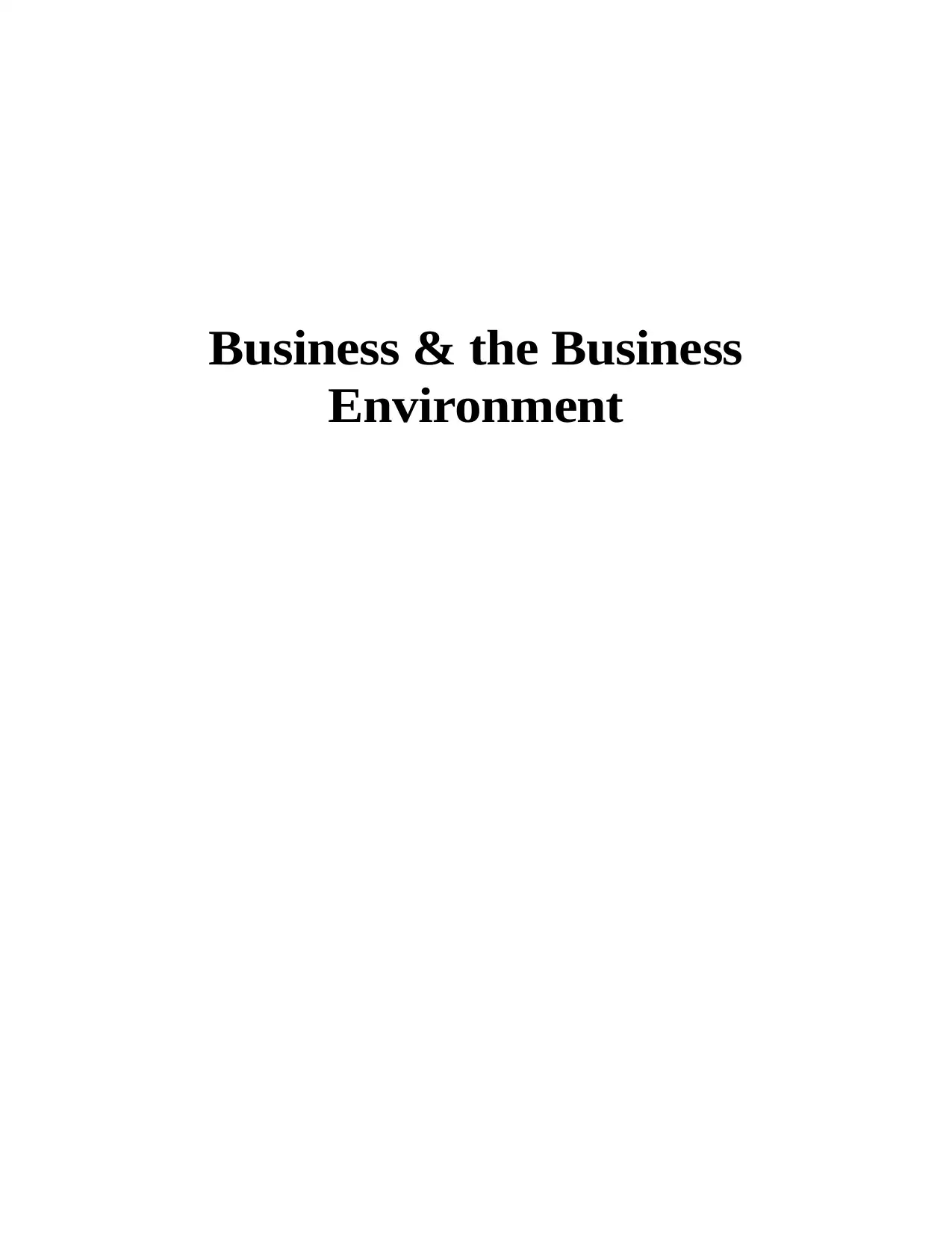
Business & the Business
Environment
Environment
Secure Best Marks with AI Grader
Need help grading? Try our AI Grader for instant feedback on your assignments.
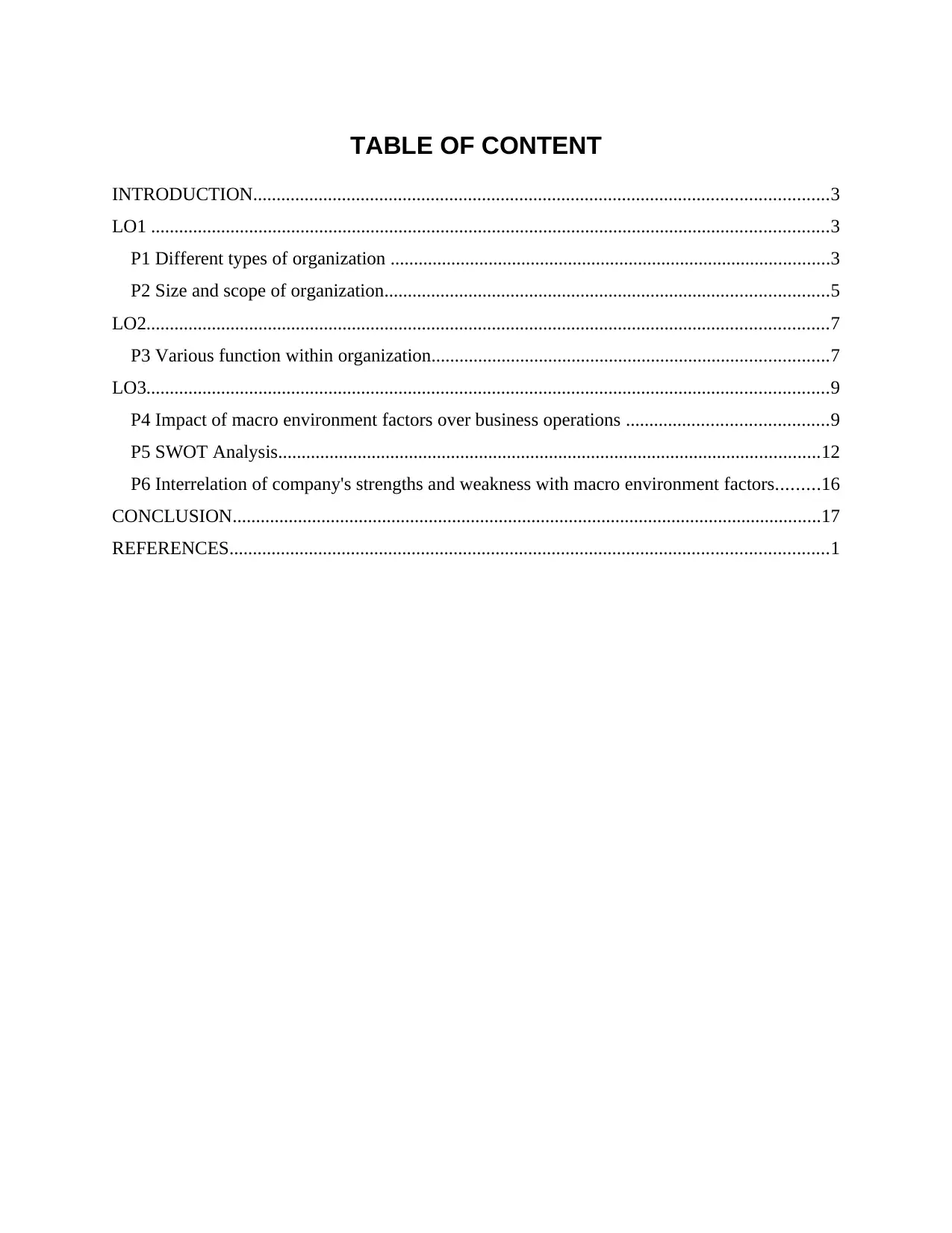
TABLE OF CONTENT
INTRODUCTION...........................................................................................................................3
LO1 .................................................................................................................................................3
P1 Different types of organization ..............................................................................................3
P2 Size and scope of organization...............................................................................................5
LO2..................................................................................................................................................7
P3 Various function within organization.....................................................................................7
LO3..................................................................................................................................................9
P4 Impact of macro environment factors over business operations ...........................................9
P5 SWOT Analysis....................................................................................................................12
P6 Interrelation of company's strengths and weakness with macro environment factors.........16
CONCLUSION..............................................................................................................................17
REFERENCES................................................................................................................................1
INTRODUCTION...........................................................................................................................3
LO1 .................................................................................................................................................3
P1 Different types of organization ..............................................................................................3
P2 Size and scope of organization...............................................................................................5
LO2..................................................................................................................................................7
P3 Various function within organization.....................................................................................7
LO3..................................................................................................................................................9
P4 Impact of macro environment factors over business operations ...........................................9
P5 SWOT Analysis....................................................................................................................12
P6 Interrelation of company's strengths and weakness with macro environment factors.........16
CONCLUSION..............................................................................................................................17
REFERENCES................................................................................................................................1
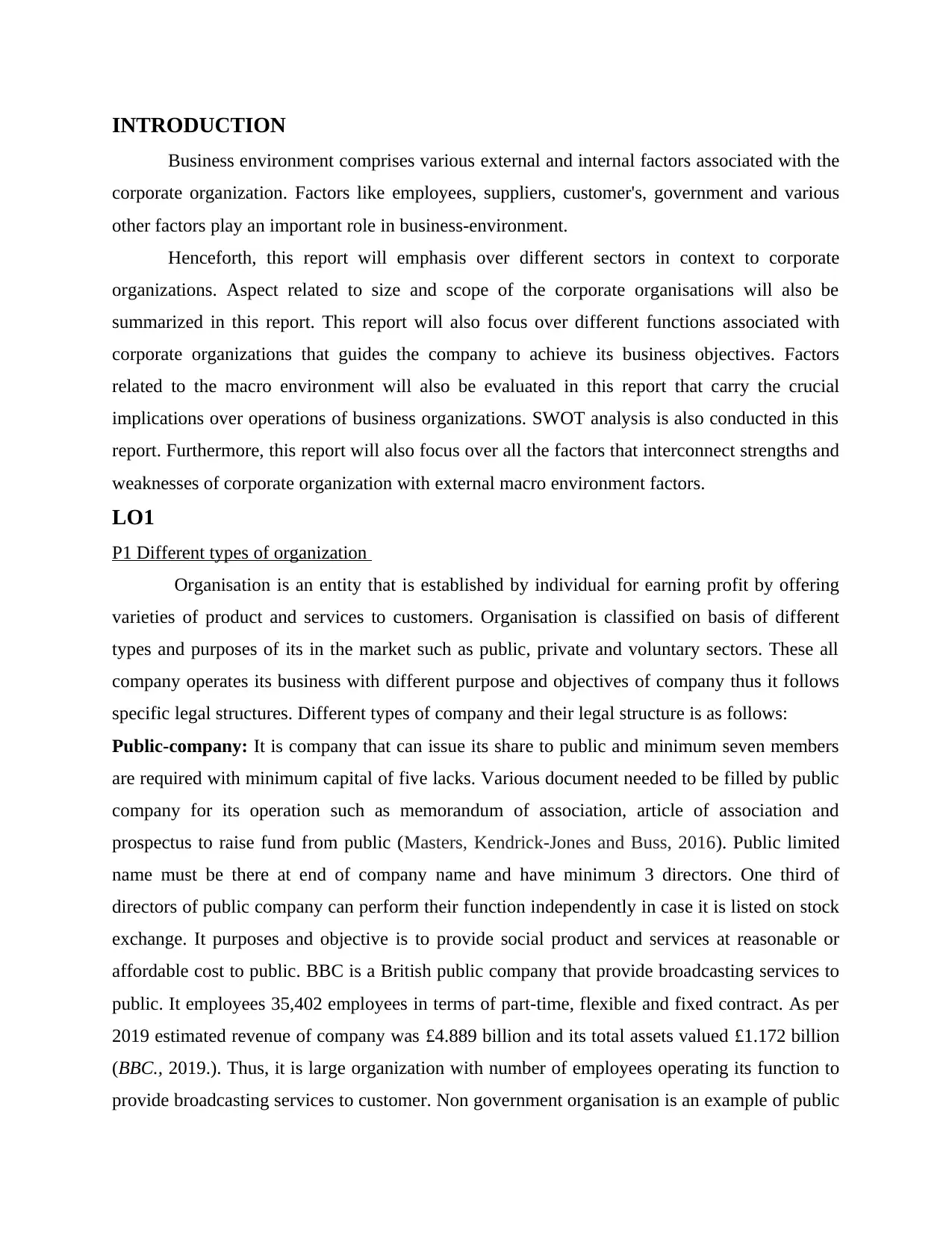
INTRODUCTION
Business environment comprises various external and internal factors associated with the
corporate organization. Factors like employees, suppliers, customer's, government and various
other factors play an important role in business-environment.
Henceforth, this report will emphasis over different sectors in context to corporate
organizations. Aspect related to size and scope of the corporate organisations will also be
summarized in this report. This report will also focus over different functions associated with
corporate organizations that guides the company to achieve its business objectives. Factors
related to the macro environment will also be evaluated in this report that carry the crucial
implications over operations of business organizations. SWOT analysis is also conducted in this
report. Furthermore, this report will also focus over all the factors that interconnect strengths and
weaknesses of corporate organization with external macro environment factors.
LO1
P1 Different types of organization
Organisation is an entity that is established by individual for earning profit by offering
varieties of product and services to customers. Organisation is classified on basis of different
types and purposes of its in the market such as public, private and voluntary sectors. These all
company operates its business with different purpose and objectives of company thus it follows
specific legal structures. Different types of company and their legal structure is as follows:
Public-company: It is company that can issue its share to public and minimum seven members
are required with minimum capital of five lacks. Various document needed to be filled by public
company for its operation such as memorandum of association, article of association and
prospectus to raise fund from public (Masters, Kendrick-Jones and Buss, 2016). Public limited
name must be there at end of company name and have minimum 3 directors. One third of
directors of public company can perform their function independently in case it is listed on stock
exchange. It purposes and objective is to provide social product and services at reasonable or
affordable cost to public. BBC is a British public company that provide broadcasting services to
public. It employees 35,402 employees in terms of part-time, flexible and fixed contract. As per
2019 estimated revenue of company was £4.889 billion and its total assets valued £1.172 billion
(BBC., 2019.). Thus, it is large organization with number of employees operating its function to
provide broadcasting services to customer. Non government organisation is an example of public
Business environment comprises various external and internal factors associated with the
corporate organization. Factors like employees, suppliers, customer's, government and various
other factors play an important role in business-environment.
Henceforth, this report will emphasis over different sectors in context to corporate
organizations. Aspect related to size and scope of the corporate organisations will also be
summarized in this report. This report will also focus over different functions associated with
corporate organizations that guides the company to achieve its business objectives. Factors
related to the macro environment will also be evaluated in this report that carry the crucial
implications over operations of business organizations. SWOT analysis is also conducted in this
report. Furthermore, this report will also focus over all the factors that interconnect strengths and
weaknesses of corporate organization with external macro environment factors.
LO1
P1 Different types of organization
Organisation is an entity that is established by individual for earning profit by offering
varieties of product and services to customers. Organisation is classified on basis of different
types and purposes of its in the market such as public, private and voluntary sectors. These all
company operates its business with different purpose and objectives of company thus it follows
specific legal structures. Different types of company and their legal structure is as follows:
Public-company: It is company that can issue its share to public and minimum seven members
are required with minimum capital of five lacks. Various document needed to be filled by public
company for its operation such as memorandum of association, article of association and
prospectus to raise fund from public (Masters, Kendrick-Jones and Buss, 2016). Public limited
name must be there at end of company name and have minimum 3 directors. One third of
directors of public company can perform their function independently in case it is listed on stock
exchange. It purposes and objective is to provide social product and services at reasonable or
affordable cost to public. BBC is a British public company that provide broadcasting services to
public. It employees 35,402 employees in terms of part-time, flexible and fixed contract. As per
2019 estimated revenue of company was £4.889 billion and its total assets valued £1.172 billion
(BBC., 2019.). Thus, it is large organization with number of employees operating its function to
provide broadcasting services to customer. Non government organisation is an example of public
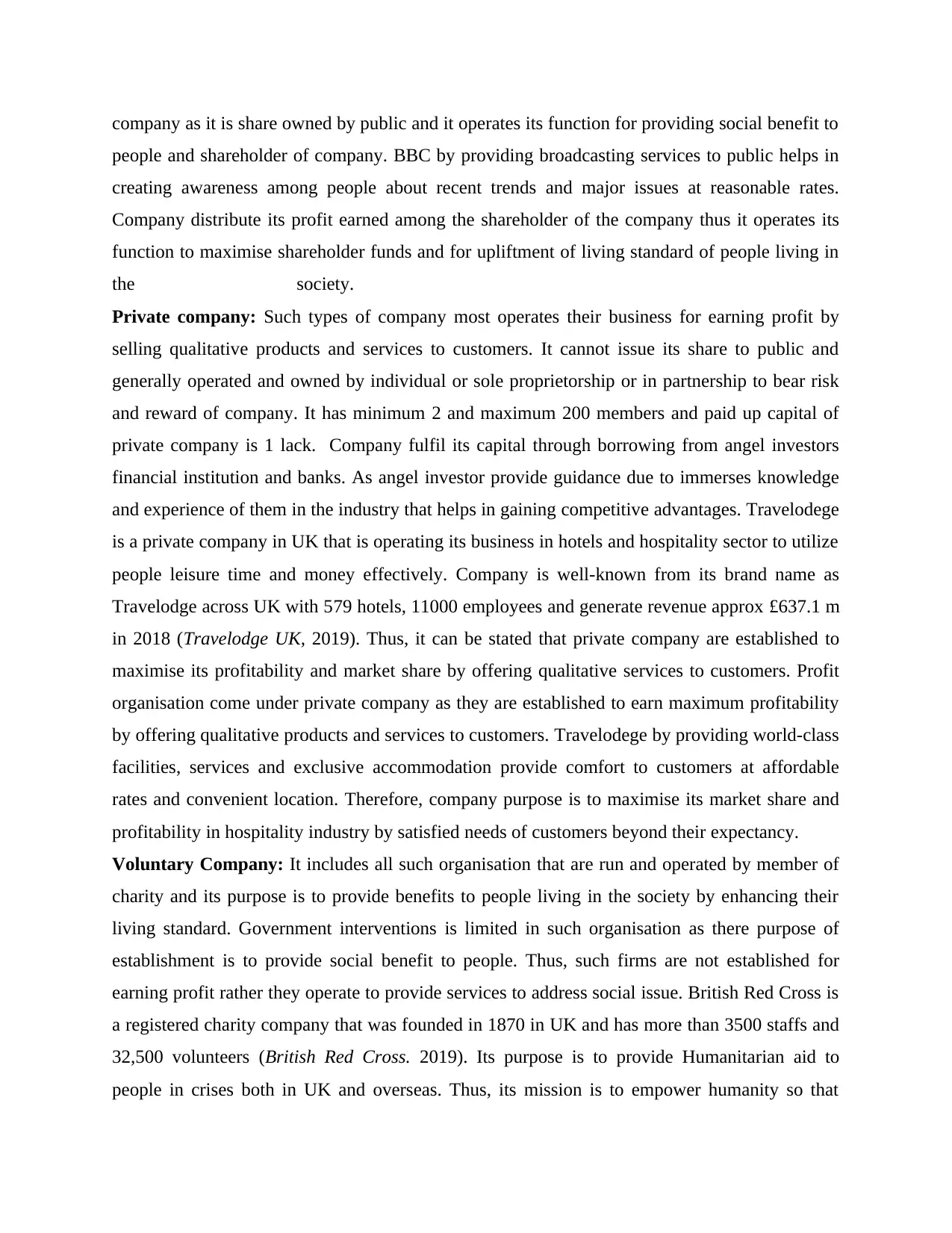
company as it is share owned by public and it operates its function for providing social benefit to
people and shareholder of company. BBC by providing broadcasting services to public helps in
creating awareness among people about recent trends and major issues at reasonable rates.
Company distribute its profit earned among the shareholder of the company thus it operates its
function to maximise shareholder funds and for upliftment of living standard of people living in
the society.
Private company: Such types of company most operates their business for earning profit by
selling qualitative products and services to customers. It cannot issue its share to public and
generally operated and owned by individual or sole proprietorship or in partnership to bear risk
and reward of company. It has minimum 2 and maximum 200 members and paid up capital of
private company is 1 lack. Company fulfil its capital through borrowing from angel investors
financial institution and banks. As angel investor provide guidance due to immerses knowledge
and experience of them in the industry that helps in gaining competitive advantages. Travelodege
is a private company in UK that is operating its business in hotels and hospitality sector to utilize
people leisure time and money effectively. Company is well-known from its brand name as
Travelodge across UK with 579 hotels, 11000 employees and generate revenue approx £637.1 m
in 2018 (Travelodge UK, 2019). Thus, it can be stated that private company are established to
maximise its profitability and market share by offering qualitative services to customers. Profit
organisation come under private company as they are established to earn maximum profitability
by offering qualitative products and services to customers. Travelodege by providing world-class
facilities, services and exclusive accommodation provide comfort to customers at affordable
rates and convenient location. Therefore, company purpose is to maximise its market share and
profitability in hospitality industry by satisfied needs of customers beyond their expectancy.
Voluntary Company: It includes all such organisation that are run and operated by member of
charity and its purpose is to provide benefits to people living in the society by enhancing their
living standard. Government interventions is limited in such organisation as there purpose of
establishment is to provide social benefit to people. Thus, such firms are not established for
earning profit rather they operate to provide services to address social issue. British Red Cross is
a registered charity company that was founded in 1870 in UK and has more than 3500 staffs and
32,500 volunteers (British Red Cross. 2019). Its purpose is to provide Humanitarian aid to
people in crises both in UK and overseas. Thus, its mission is to empower humanity so that
people and shareholder of company. BBC by providing broadcasting services to public helps in
creating awareness among people about recent trends and major issues at reasonable rates.
Company distribute its profit earned among the shareholder of the company thus it operates its
function to maximise shareholder funds and for upliftment of living standard of people living in
the society.
Private company: Such types of company most operates their business for earning profit by
selling qualitative products and services to customers. It cannot issue its share to public and
generally operated and owned by individual or sole proprietorship or in partnership to bear risk
and reward of company. It has minimum 2 and maximum 200 members and paid up capital of
private company is 1 lack. Company fulfil its capital through borrowing from angel investors
financial institution and banks. As angel investor provide guidance due to immerses knowledge
and experience of them in the industry that helps in gaining competitive advantages. Travelodege
is a private company in UK that is operating its business in hotels and hospitality sector to utilize
people leisure time and money effectively. Company is well-known from its brand name as
Travelodge across UK with 579 hotels, 11000 employees and generate revenue approx £637.1 m
in 2018 (Travelodge UK, 2019). Thus, it can be stated that private company are established to
maximise its profitability and market share by offering qualitative services to customers. Profit
organisation come under private company as they are established to earn maximum profitability
by offering qualitative products and services to customers. Travelodege by providing world-class
facilities, services and exclusive accommodation provide comfort to customers at affordable
rates and convenient location. Therefore, company purpose is to maximise its market share and
profitability in hospitality industry by satisfied needs of customers beyond their expectancy.
Voluntary Company: It includes all such organisation that are run and operated by member of
charity and its purpose is to provide benefits to people living in the society by enhancing their
living standard. Government interventions is limited in such organisation as there purpose of
establishment is to provide social benefit to people. Thus, such firms are not established for
earning profit rather they operate to provide services to address social issue. British Red Cross is
a registered charity company that was founded in 1870 in UK and has more than 3500 staffs and
32,500 volunteers (British Red Cross. 2019). Its purpose is to provide Humanitarian aid to
people in crises both in UK and overseas. Thus, its mission is to empower humanity so that
Paraphrase This Document
Need a fresh take? Get an instant paraphrase of this document with our AI Paraphraser
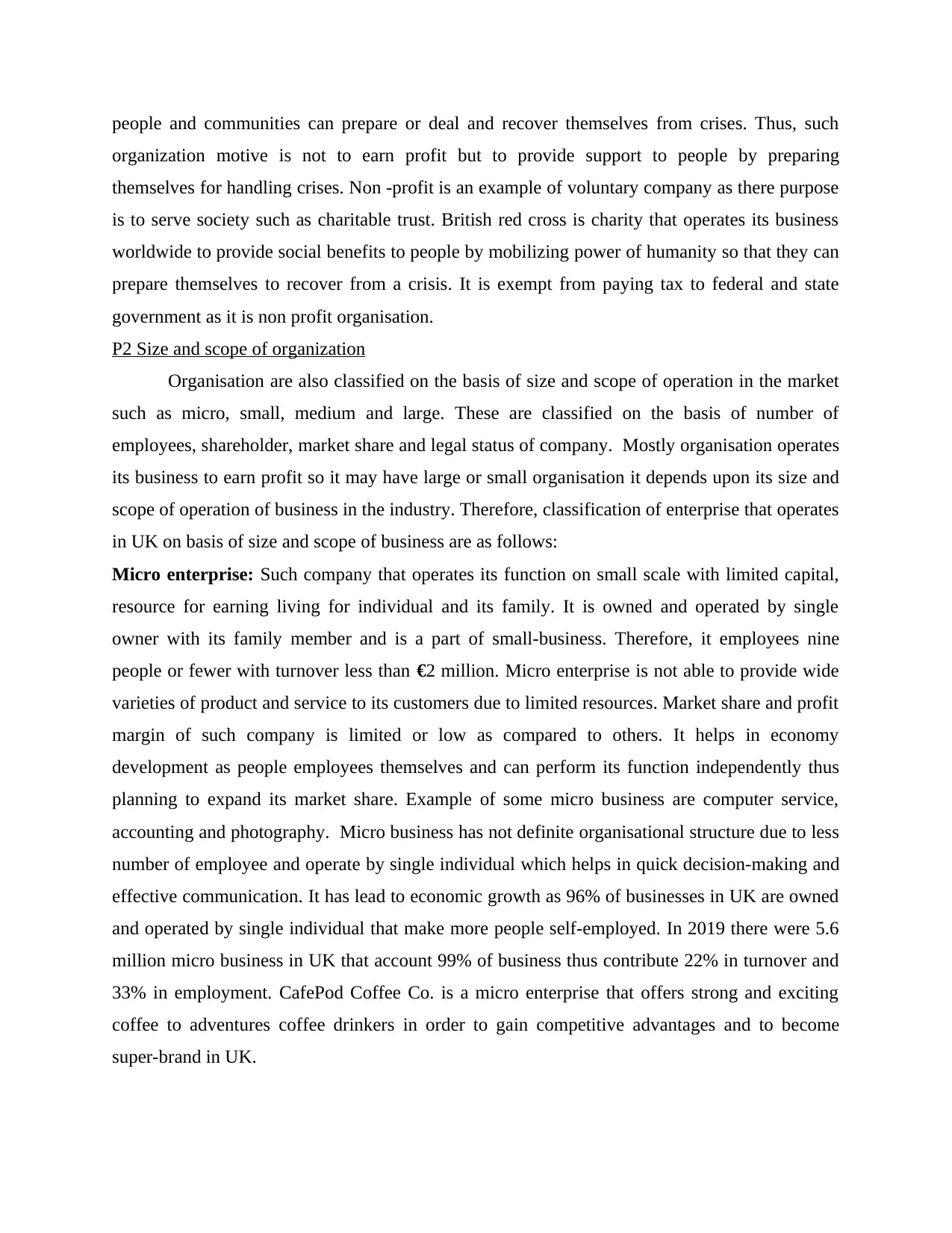
people and communities can prepare or deal and recover themselves from crises. Thus, such
organization motive is not to earn profit but to provide support to people by preparing
themselves for handling crises. Non -profit is an example of voluntary company as there purpose
is to serve society such as charitable trust. British red cross is charity that operates its business
worldwide to provide social benefits to people by mobilizing power of humanity so that they can
prepare themselves to recover from a crisis. It is exempt from paying tax to federal and state
government as it is non profit organisation.
P2 Size and scope of organization
Organisation are also classified on the basis of size and scope of operation in the market
such as micro, small, medium and large. These are classified on the basis of number of
employees, shareholder, market share and legal status of company. Mostly organisation operates
its business to earn profit so it may have large or small organisation it depends upon its size and
scope of operation of business in the industry. Therefore, classification of enterprise that operates
in UK on basis of size and scope of business are as follows:
Micro enterprise: Such company that operates its function on small scale with limited capital,
resource for earning living for individual and its family. It is owned and operated by single
owner with its family member and is a part of small-business. Therefore, it employees nine
people or fewer with turnover less than €2 million. Micro enterprise is not able to provide wide
varieties of product and service to its customers due to limited resources. Market share and profit
margin of such company is limited or low as compared to others. It helps in economy
development as people employees themselves and can perform its function independently thus
planning to expand its market share. Example of some micro business are computer service,
accounting and photography. Micro business has not definite organisational structure due to less
number of employee and operate by single individual which helps in quick decision-making and
effective communication. It has lead to economic growth as 96% of businesses in UK are owned
and operated by single individual that make more people self-employed. In 2019 there were 5.6
million micro business in UK that account 99% of business thus contribute 22% in turnover and
33% in employment. CafePod Coffee Co. is a micro enterprise that offers strong and exciting
coffee to adventures coffee drinkers in order to gain competitive advantages and to become
super-brand in UK.
organization motive is not to earn profit but to provide support to people by preparing
themselves for handling crises. Non -profit is an example of voluntary company as there purpose
is to serve society such as charitable trust. British red cross is charity that operates its business
worldwide to provide social benefits to people by mobilizing power of humanity so that they can
prepare themselves to recover from a crisis. It is exempt from paying tax to federal and state
government as it is non profit organisation.
P2 Size and scope of organization
Organisation are also classified on the basis of size and scope of operation in the market
such as micro, small, medium and large. These are classified on the basis of number of
employees, shareholder, market share and legal status of company. Mostly organisation operates
its business to earn profit so it may have large or small organisation it depends upon its size and
scope of operation of business in the industry. Therefore, classification of enterprise that operates
in UK on basis of size and scope of business are as follows:
Micro enterprise: Such company that operates its function on small scale with limited capital,
resource for earning living for individual and its family. It is owned and operated by single
owner with its family member and is a part of small-business. Therefore, it employees nine
people or fewer with turnover less than €2 million. Micro enterprise is not able to provide wide
varieties of product and service to its customers due to limited resources. Market share and profit
margin of such company is limited or low as compared to others. It helps in economy
development as people employees themselves and can perform its function independently thus
planning to expand its market share. Example of some micro business are computer service,
accounting and photography. Micro business has not definite organisational structure due to less
number of employee and operate by single individual which helps in quick decision-making and
effective communication. It has lead to economic growth as 96% of businesses in UK are owned
and operated by single individual that make more people self-employed. In 2019 there were 5.6
million micro business in UK that account 99% of business thus contribute 22% in turnover and
33% in employment. CafePod Coffee Co. is a micro enterprise that offers strong and exciting
coffee to adventures coffee drinkers in order to gain competitive advantages and to become
super-brand in UK.
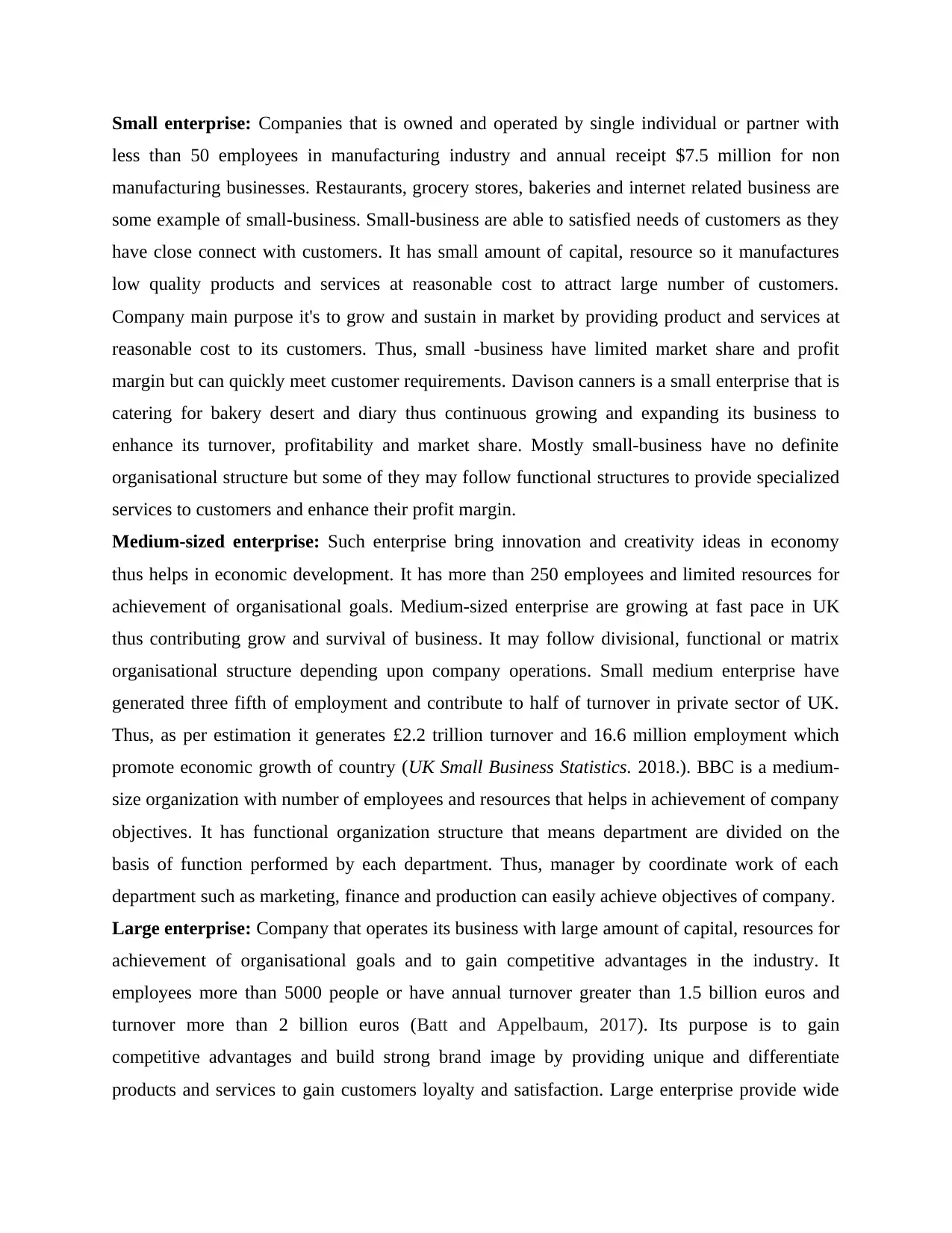
Small enterprise: Companies that is owned and operated by single individual or partner with
less than 50 employees in manufacturing industry and annual receipt $7.5 million for non
manufacturing businesses. Restaurants, grocery stores, bakeries and internet related business are
some example of small-business. Small-business are able to satisfied needs of customers as they
have close connect with customers. It has small amount of capital, resource so it manufactures
low quality products and services at reasonable cost to attract large number of customers.
Company main purpose it's to grow and sustain in market by providing product and services at
reasonable cost to its customers. Thus, small -business have limited market share and profit
margin but can quickly meet customer requirements. Davison canners is a small enterprise that is
catering for bakery desert and diary thus continuous growing and expanding its business to
enhance its turnover, profitability and market share. Mostly small-business have no definite
organisational structure but some of they may follow functional structures to provide specialized
services to customers and enhance their profit margin.
Medium-sized enterprise: Such enterprise bring innovation and creativity ideas in economy
thus helps in economic development. It has more than 250 employees and limited resources for
achievement of organisational goals. Medium-sized enterprise are growing at fast pace in UK
thus contributing grow and survival of business. It may follow divisional, functional or matrix
organisational structure depending upon company operations. Small medium enterprise have
generated three fifth of employment and contribute to half of turnover in private sector of UK.
Thus, as per estimation it generates £2.2 trillion turnover and 16.6 million employment which
promote economic growth of country (UK Small Business Statistics. 2018.). BBC is a medium-
size organization with number of employees and resources that helps in achievement of company
objectives. It has functional organization structure that means department are divided on the
basis of function performed by each department. Thus, manager by coordinate work of each
department such as marketing, finance and production can easily achieve objectives of company.
Large enterprise: Company that operates its business with large amount of capital, resources for
achievement of organisational goals and to gain competitive advantages in the industry. It
employees more than 5000 people or have annual turnover greater than 1.5 billion euros and
turnover more than 2 billion euros (Batt and Appelbaum, 2017). Its purpose is to gain
competitive advantages and build strong brand image by providing unique and differentiate
products and services to gain customers loyalty and satisfaction. Large enterprise provide wide
less than 50 employees in manufacturing industry and annual receipt $7.5 million for non
manufacturing businesses. Restaurants, grocery stores, bakeries and internet related business are
some example of small-business. Small-business are able to satisfied needs of customers as they
have close connect with customers. It has small amount of capital, resource so it manufactures
low quality products and services at reasonable cost to attract large number of customers.
Company main purpose it's to grow and sustain in market by providing product and services at
reasonable cost to its customers. Thus, small -business have limited market share and profit
margin but can quickly meet customer requirements. Davison canners is a small enterprise that is
catering for bakery desert and diary thus continuous growing and expanding its business to
enhance its turnover, profitability and market share. Mostly small-business have no definite
organisational structure but some of they may follow functional structures to provide specialized
services to customers and enhance their profit margin.
Medium-sized enterprise: Such enterprise bring innovation and creativity ideas in economy
thus helps in economic development. It has more than 250 employees and limited resources for
achievement of organisational goals. Medium-sized enterprise are growing at fast pace in UK
thus contributing grow and survival of business. It may follow divisional, functional or matrix
organisational structure depending upon company operations. Small medium enterprise have
generated three fifth of employment and contribute to half of turnover in private sector of UK.
Thus, as per estimation it generates £2.2 trillion turnover and 16.6 million employment which
promote economic growth of country (UK Small Business Statistics. 2018.). BBC is a medium-
size organization with number of employees and resources that helps in achievement of company
objectives. It has functional organization structure that means department are divided on the
basis of function performed by each department. Thus, manager by coordinate work of each
department such as marketing, finance and production can easily achieve objectives of company.
Large enterprise: Company that operates its business with large amount of capital, resources for
achievement of organisational goals and to gain competitive advantages in the industry. It
employees more than 5000 people or have annual turnover greater than 1.5 billion euros and
turnover more than 2 billion euros (Batt and Appelbaum, 2017). Its purpose is to gain
competitive advantages and build strong brand image by providing unique and differentiate
products and services to gain customers loyalty and satisfaction. Large enterprise provide wide
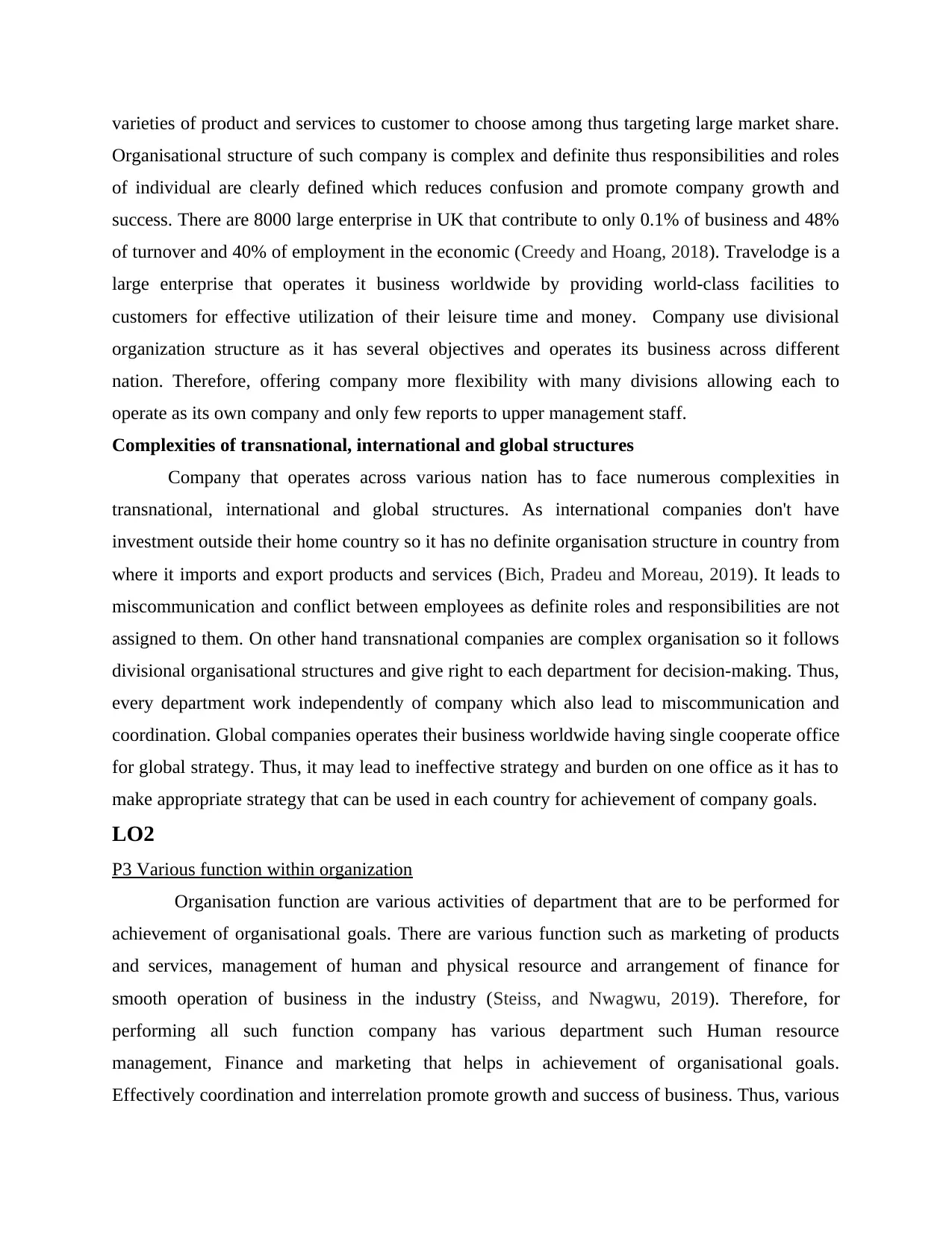
varieties of product and services to customer to choose among thus targeting large market share.
Organisational structure of such company is complex and definite thus responsibilities and roles
of individual are clearly defined which reduces confusion and promote company growth and
success. There are 8000 large enterprise in UK that contribute to only 0.1% of business and 48%
of turnover and 40% of employment in the economic (Creedy and Hoang, 2018). Travelodge is a
large enterprise that operates it business worldwide by providing world-class facilities to
customers for effective utilization of their leisure time and money. Company use divisional
organization structure as it has several objectives and operates its business across different
nation. Therefore, offering company more flexibility with many divisions allowing each to
operate as its own company and only few reports to upper management staff.
Complexities of transnational, international and global structures
Company that operates across various nation has to face numerous complexities in
transnational, international and global structures. As international companies don't have
investment outside their home country so it has no definite organisation structure in country from
where it imports and export products and services (Bich, Pradeu and Moreau, 2019). It leads to
miscommunication and conflict between employees as definite roles and responsibilities are not
assigned to them. On other hand transnational companies are complex organisation so it follows
divisional organisational structures and give right to each department for decision-making. Thus,
every department work independently of company which also lead to miscommunication and
coordination. Global companies operates their business worldwide having single cooperate office
for global strategy. Thus, it may lead to ineffective strategy and burden on one office as it has to
make appropriate strategy that can be used in each country for achievement of company goals.
LO2
P3 Various function within organization
Organisation function are various activities of department that are to be performed for
achievement of organisational goals. There are various function such as marketing of products
and services, management of human and physical resource and arrangement of finance for
smooth operation of business in the industry (Steiss, and Nwagwu, 2019). Therefore, for
performing all such function company has various department such Human resource
management, Finance and marketing that helps in achievement of organisational goals.
Effectively coordination and interrelation promote growth and success of business. Thus, various
Organisational structure of such company is complex and definite thus responsibilities and roles
of individual are clearly defined which reduces confusion and promote company growth and
success. There are 8000 large enterprise in UK that contribute to only 0.1% of business and 48%
of turnover and 40% of employment in the economic (Creedy and Hoang, 2018). Travelodge is a
large enterprise that operates it business worldwide by providing world-class facilities to
customers for effective utilization of their leisure time and money. Company use divisional
organization structure as it has several objectives and operates its business across different
nation. Therefore, offering company more flexibility with many divisions allowing each to
operate as its own company and only few reports to upper management staff.
Complexities of transnational, international and global structures
Company that operates across various nation has to face numerous complexities in
transnational, international and global structures. As international companies don't have
investment outside their home country so it has no definite organisation structure in country from
where it imports and export products and services (Bich, Pradeu and Moreau, 2019). It leads to
miscommunication and conflict between employees as definite roles and responsibilities are not
assigned to them. On other hand transnational companies are complex organisation so it follows
divisional organisational structures and give right to each department for decision-making. Thus,
every department work independently of company which also lead to miscommunication and
coordination. Global companies operates their business worldwide having single cooperate office
for global strategy. Thus, it may lead to ineffective strategy and burden on one office as it has to
make appropriate strategy that can be used in each country for achievement of company goals.
LO2
P3 Various function within organization
Organisation function are various activities of department that are to be performed for
achievement of organisational goals. There are various function such as marketing of products
and services, management of human and physical resource and arrangement of finance for
smooth operation of business in the industry (Steiss, and Nwagwu, 2019). Therefore, for
performing all such function company has various department such Human resource
management, Finance and marketing that helps in achievement of organisational goals.
Effectively coordination and interrelation promote growth and success of business. Thus, various
Secure Best Marks with AI Grader
Need help grading? Try our AI Grader for instant feedback on your assignments.
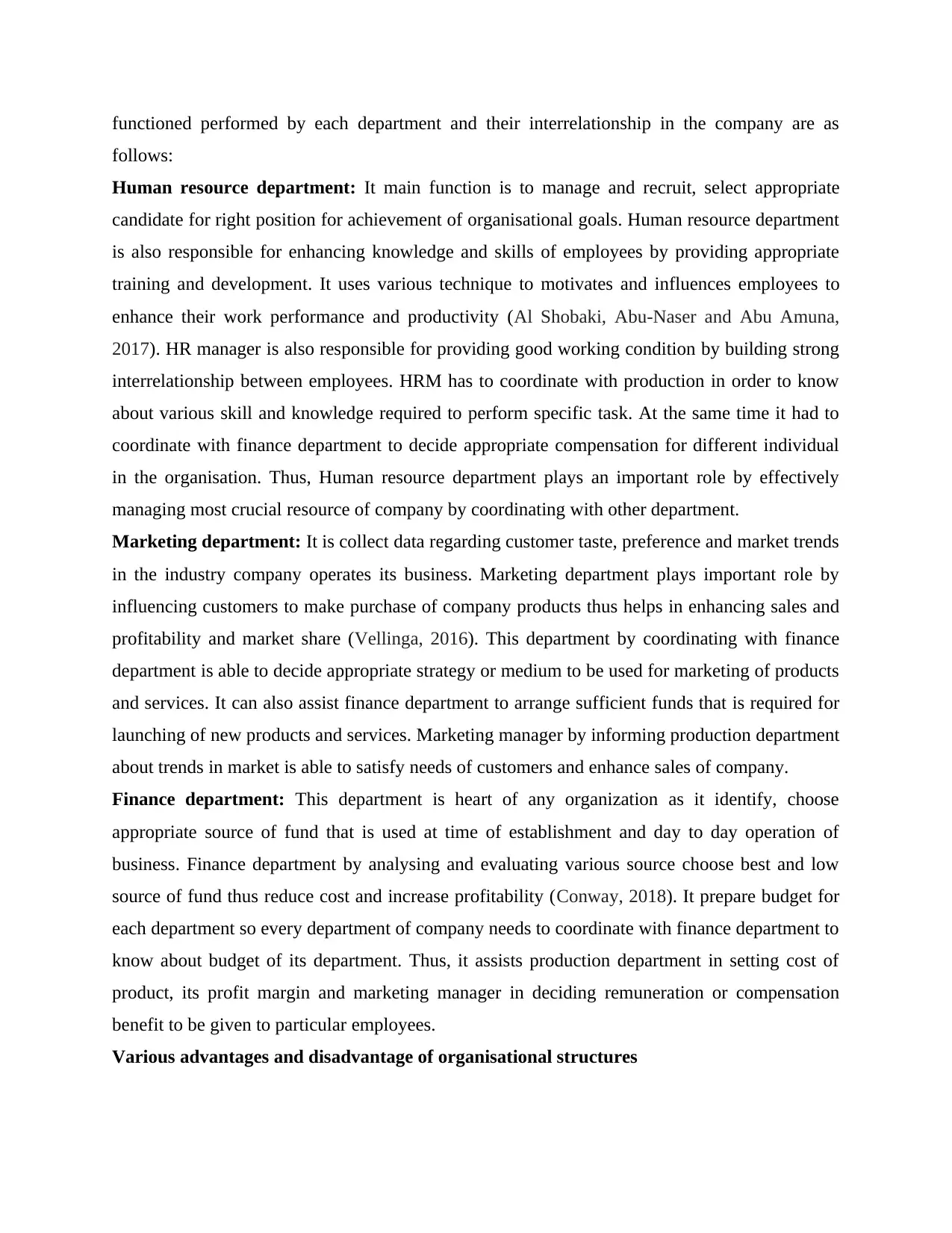
functioned performed by each department and their interrelationship in the company are as
follows:
Human resource department: It main function is to manage and recruit, select appropriate
candidate for right position for achievement of organisational goals. Human resource department
is also responsible for enhancing knowledge and skills of employees by providing appropriate
training and development. It uses various technique to motivates and influences employees to
enhance their work performance and productivity (Al Shobaki, Abu-Naser and Abu Amuna,
2017). HR manager is also responsible for providing good working condition by building strong
interrelationship between employees. HRM has to coordinate with production in order to know
about various skill and knowledge required to perform specific task. At the same time it had to
coordinate with finance department to decide appropriate compensation for different individual
in the organisation. Thus, Human resource department plays an important role by effectively
managing most crucial resource of company by coordinating with other department.
Marketing department: It is collect data regarding customer taste, preference and market trends
in the industry company operates its business. Marketing department plays important role by
influencing customers to make purchase of company products thus helps in enhancing sales and
profitability and market share (Vellinga, 2016). This department by coordinating with finance
department is able to decide appropriate strategy or medium to be used for marketing of products
and services. It can also assist finance department to arrange sufficient funds that is required for
launching of new products and services. Marketing manager by informing production department
about trends in market is able to satisfy needs of customers and enhance sales of company.
Finance department: This department is heart of any organization as it identify, choose
appropriate source of fund that is used at time of establishment and day to day operation of
business. Finance department by analysing and evaluating various source choose best and low
source of fund thus reduce cost and increase profitability (Conway, 2018). It prepare budget for
each department so every department of company needs to coordinate with finance department to
know about budget of its department. Thus, it assists production department in setting cost of
product, its profit margin and marketing manager in deciding remuneration or compensation
benefit to be given to particular employees.
Various advantages and disadvantage of organisational structures
follows:
Human resource department: It main function is to manage and recruit, select appropriate
candidate for right position for achievement of organisational goals. Human resource department
is also responsible for enhancing knowledge and skills of employees by providing appropriate
training and development. It uses various technique to motivates and influences employees to
enhance their work performance and productivity (Al Shobaki, Abu-Naser and Abu Amuna,
2017). HR manager is also responsible for providing good working condition by building strong
interrelationship between employees. HRM has to coordinate with production in order to know
about various skill and knowledge required to perform specific task. At the same time it had to
coordinate with finance department to decide appropriate compensation for different individual
in the organisation. Thus, Human resource department plays an important role by effectively
managing most crucial resource of company by coordinating with other department.
Marketing department: It is collect data regarding customer taste, preference and market trends
in the industry company operates its business. Marketing department plays important role by
influencing customers to make purchase of company products thus helps in enhancing sales and
profitability and market share (Vellinga, 2016). This department by coordinating with finance
department is able to decide appropriate strategy or medium to be used for marketing of products
and services. It can also assist finance department to arrange sufficient funds that is required for
launching of new products and services. Marketing manager by informing production department
about trends in market is able to satisfy needs of customers and enhance sales of company.
Finance department: This department is heart of any organization as it identify, choose
appropriate source of fund that is used at time of establishment and day to day operation of
business. Finance department by analysing and evaluating various source choose best and low
source of fund thus reduce cost and increase profitability (Conway, 2018). It prepare budget for
each department so every department of company needs to coordinate with finance department to
know about budget of its department. Thus, it assists production department in setting cost of
product, its profit margin and marketing manager in deciding remuneration or compensation
benefit to be given to particular employees.
Various advantages and disadvantage of organisational structures
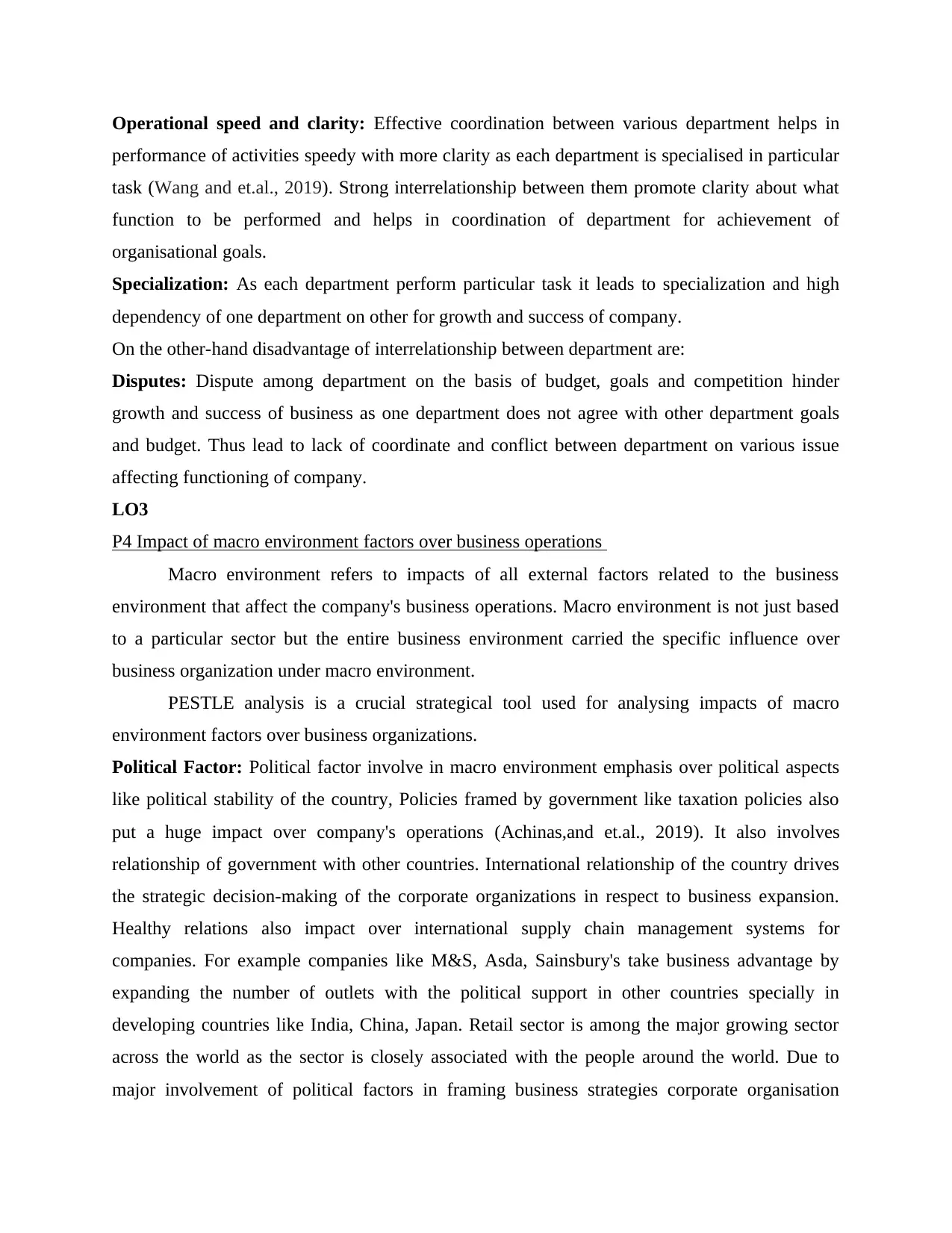
Operational speed and clarity: Effective coordination between various department helps in
performance of activities speedy with more clarity as each department is specialised in particular
task (Wang and et.al., 2019). Strong interrelationship between them promote clarity about what
function to be performed and helps in coordination of department for achievement of
organisational goals.
Specialization: As each department perform particular task it leads to specialization and high
dependency of one department on other for growth and success of company.
On the other-hand disadvantage of interrelationship between department are:
Disputes: Dispute among department on the basis of budget, goals and competition hinder
growth and success of business as one department does not agree with other department goals
and budget. Thus lead to lack of coordinate and conflict between department on various issue
affecting functioning of company.
LO3
P4 Impact of macro environment factors over business operations
Macro environment refers to impacts of all external factors related to the business
environment that affect the company's business operations. Macro environment is not just based
to a particular sector but the entire business environment carried the specific influence over
business organization under macro environment.
PESTLE analysis is a crucial strategical tool used for analysing impacts of macro
environment factors over business organizations.
Political Factor: Political factor involve in macro environment emphasis over political aspects
like political stability of the country, Policies framed by government like taxation policies also
put a huge impact over company's operations (Achinas,and et.al., 2019). It also involves
relationship of government with other countries. International relationship of the country drives
the strategic decision-making of the corporate organizations in respect to business expansion.
Healthy relations also impact over international supply chain management systems for
companies. For example companies like M&S, Asda, Sainsbury's take business advantage by
expanding the number of outlets with the political support in other countries specially in
developing countries like India, China, Japan. Retail sector is among the major growing sector
across the world as the sector is closely associated with the people around the world. Due to
major involvement of political factors in framing business strategies corporate organisation
performance of activities speedy with more clarity as each department is specialised in particular
task (Wang and et.al., 2019). Strong interrelationship between them promote clarity about what
function to be performed and helps in coordination of department for achievement of
organisational goals.
Specialization: As each department perform particular task it leads to specialization and high
dependency of one department on other for growth and success of company.
On the other-hand disadvantage of interrelationship between department are:
Disputes: Dispute among department on the basis of budget, goals and competition hinder
growth and success of business as one department does not agree with other department goals
and budget. Thus lead to lack of coordinate and conflict between department on various issue
affecting functioning of company.
LO3
P4 Impact of macro environment factors over business operations
Macro environment refers to impacts of all external factors related to the business
environment that affect the company's business operations. Macro environment is not just based
to a particular sector but the entire business environment carried the specific influence over
business organization under macro environment.
PESTLE analysis is a crucial strategical tool used for analysing impacts of macro
environment factors over business organizations.
Political Factor: Political factor involve in macro environment emphasis over political aspects
like political stability of the country, Policies framed by government like taxation policies also
put a huge impact over company's operations (Achinas,and et.al., 2019). It also involves
relationship of government with other countries. International relationship of the country drives
the strategic decision-making of the corporate organizations in respect to business expansion.
Healthy relations also impact over international supply chain management systems for
companies. For example companies like M&S, Asda, Sainsbury's take business advantage by
expanding the number of outlets with the political support in other countries specially in
developing countries like India, China, Japan. Retail sector is among the major growing sector
across the world as the sector is closely associated with the people around the world. Due to
major involvement of political factors in framing business strategies corporate organisation
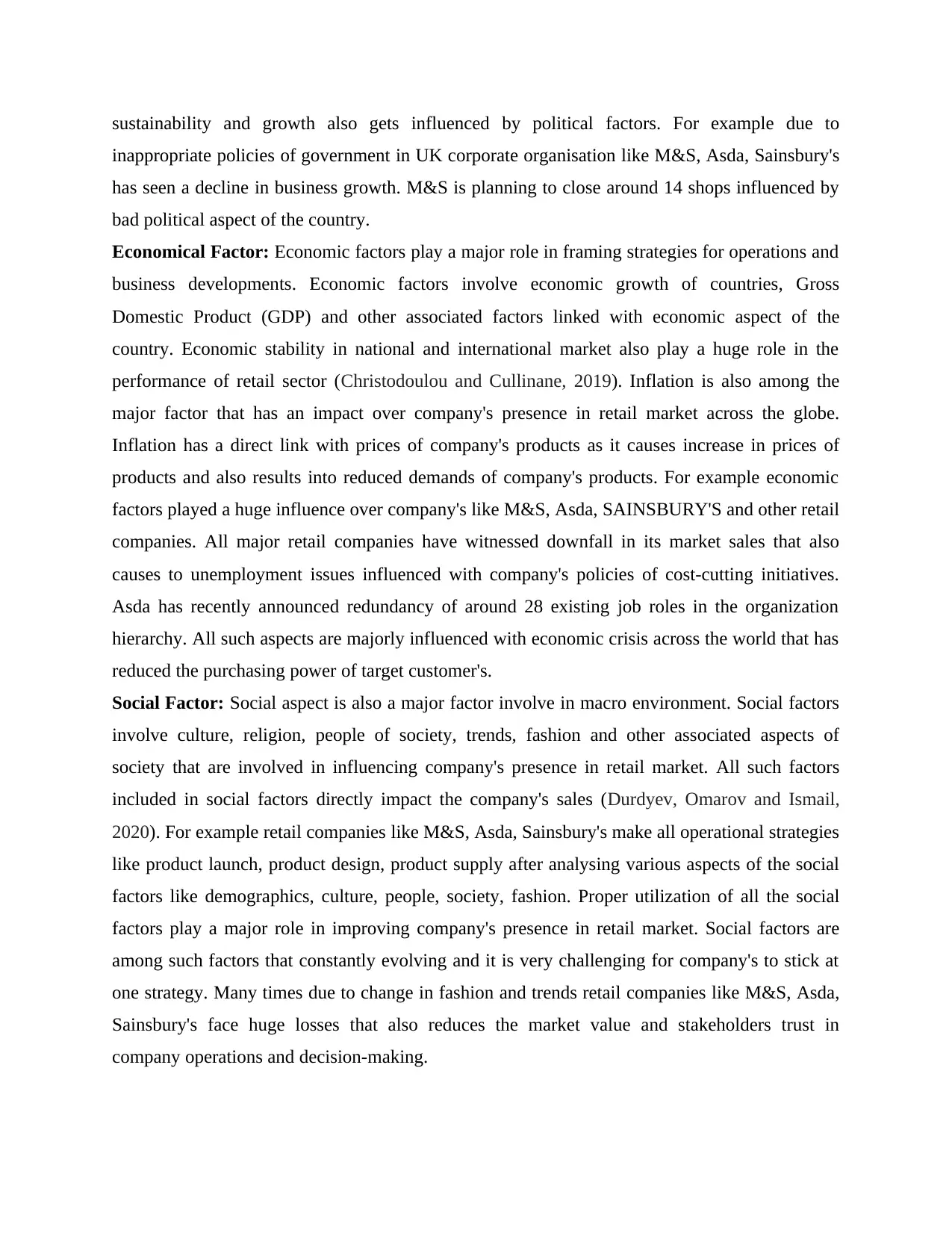
sustainability and growth also gets influenced by political factors. For example due to
inappropriate policies of government in UK corporate organisation like M&S, Asda, Sainsbury's
has seen a decline in business growth. M&S is planning to close around 14 shops influenced by
bad political aspect of the country.
Economical Factor: Economic factors play a major role in framing strategies for operations and
business developments. Economic factors involve economic growth of countries, Gross
Domestic Product (GDP) and other associated factors linked with economic aspect of the
country. Economic stability in national and international market also play a huge role in the
performance of retail sector (Christodoulou and Cullinane, 2019). Inflation is also among the
major factor that has an impact over company's presence in retail market across the globe.
Inflation has a direct link with prices of company's products as it causes increase in prices of
products and also results into reduced demands of company's products. For example economic
factors played a huge influence over company's like M&S, Asda, SAINSBURY'S and other retail
companies. All major retail companies have witnessed downfall in its market sales that also
causes to unemployment issues influenced with company's policies of cost-cutting initiatives.
Asda has recently announced redundancy of around 28 existing job roles in the organization
hierarchy. All such aspects are majorly influenced with economic crisis across the world that has
reduced the purchasing power of target customer's.
Social Factor: Social aspect is also a major factor involve in macro environment. Social factors
involve culture, religion, people of society, trends, fashion and other associated aspects of
society that are involved in influencing company's presence in retail market. All such factors
included in social factors directly impact the company's sales (Durdyev, Omarov and Ismail,
2020). For example retail companies like M&S, Asda, Sainsbury's make all operational strategies
like product launch, product design, product supply after analysing various aspects of the social
factors like demographics, culture, people, society, fashion. Proper utilization of all the social
factors play a major role in improving company's presence in retail market. Social factors are
among such factors that constantly evolving and it is very challenging for company's to stick at
one strategy. Many times due to change in fashion and trends retail companies like M&S, Asda,
Sainsbury's face huge losses that also reduces the market value and stakeholders trust in
company operations and decision-making.
inappropriate policies of government in UK corporate organisation like M&S, Asda, Sainsbury's
has seen a decline in business growth. M&S is planning to close around 14 shops influenced by
bad political aspect of the country.
Economical Factor: Economic factors play a major role in framing strategies for operations and
business developments. Economic factors involve economic growth of countries, Gross
Domestic Product (GDP) and other associated factors linked with economic aspect of the
country. Economic stability in national and international market also play a huge role in the
performance of retail sector (Christodoulou and Cullinane, 2019). Inflation is also among the
major factor that has an impact over company's presence in retail market across the globe.
Inflation has a direct link with prices of company's products as it causes increase in prices of
products and also results into reduced demands of company's products. For example economic
factors played a huge influence over company's like M&S, Asda, SAINSBURY'S and other retail
companies. All major retail companies have witnessed downfall in its market sales that also
causes to unemployment issues influenced with company's policies of cost-cutting initiatives.
Asda has recently announced redundancy of around 28 existing job roles in the organization
hierarchy. All such aspects are majorly influenced with economic crisis across the world that has
reduced the purchasing power of target customer's.
Social Factor: Social aspect is also a major factor involve in macro environment. Social factors
involve culture, religion, people of society, trends, fashion and other associated aspects of
society that are involved in influencing company's presence in retail market. All such factors
included in social factors directly impact the company's sales (Durdyev, Omarov and Ismail,
2020). For example retail companies like M&S, Asda, Sainsbury's make all operational strategies
like product launch, product design, product supply after analysing various aspects of the social
factors like demographics, culture, people, society, fashion. Proper utilization of all the social
factors play a major role in improving company's presence in retail market. Social factors are
among such factors that constantly evolving and it is very challenging for company's to stick at
one strategy. Many times due to change in fashion and trends retail companies like M&S, Asda,
Sainsbury's face huge losses that also reduces the market value and stakeholders trust in
company operations and decision-making.
Paraphrase This Document
Need a fresh take? Get an instant paraphrase of this document with our AI Paraphraser
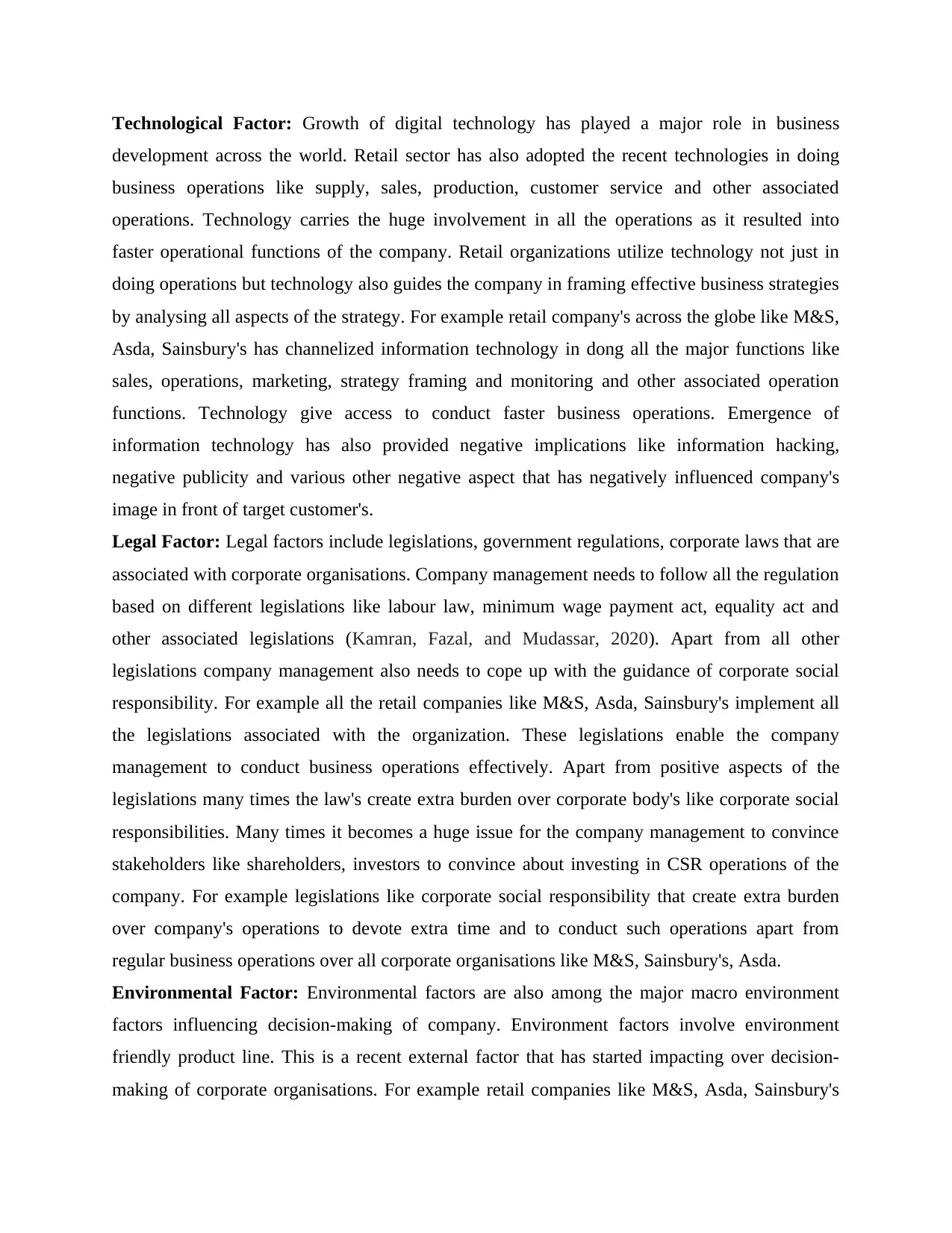
Technological Factor: Growth of digital technology has played a major role in business
development across the world. Retail sector has also adopted the recent technologies in doing
business operations like supply, sales, production, customer service and other associated
operations. Technology carries the huge involvement in all the operations as it resulted into
faster operational functions of the company. Retail organizations utilize technology not just in
doing operations but technology also guides the company in framing effective business strategies
by analysing all aspects of the strategy. For example retail company's across the globe like M&S,
Asda, Sainsbury's has channelized information technology in dong all the major functions like
sales, operations, marketing, strategy framing and monitoring and other associated operation
functions. Technology give access to conduct faster business operations. Emergence of
information technology has also provided negative implications like information hacking,
negative publicity and various other negative aspect that has negatively influenced company's
image in front of target customer's.
Legal Factor: Legal factors include legislations, government regulations, corporate laws that are
associated with corporate organisations. Company management needs to follow all the regulation
based on different legislations like labour law, minimum wage payment act, equality act and
other associated legislations (Kamran, Fazal, and Mudassar, 2020). Apart from all other
legislations company management also needs to cope up with the guidance of corporate social
responsibility. For example all the retail companies like M&S, Asda, Sainsbury's implement all
the legislations associated with the organization. These legislations enable the company
management to conduct business operations effectively. Apart from positive aspects of the
legislations many times the law's create extra burden over corporate body's like corporate social
responsibilities. Many times it becomes a huge issue for the company management to convince
stakeholders like shareholders, investors to convince about investing in CSR operations of the
company. For example legislations like corporate social responsibility that create extra burden
over company's operations to devote extra time and to conduct such operations apart from
regular business operations over all corporate organisations like M&S, Sainsbury's, Asda.
Environmental Factor: Environmental factors are also among the major macro environment
factors influencing decision-making of company. Environment factors involve environment
friendly product line. This is a recent external factor that has started impacting over decision-
making of corporate organisations. For example retail companies like M&S, Asda, Sainsbury's
development across the world. Retail sector has also adopted the recent technologies in doing
business operations like supply, sales, production, customer service and other associated
operations. Technology carries the huge involvement in all the operations as it resulted into
faster operational functions of the company. Retail organizations utilize technology not just in
doing operations but technology also guides the company in framing effective business strategies
by analysing all aspects of the strategy. For example retail company's across the globe like M&S,
Asda, Sainsbury's has channelized information technology in dong all the major functions like
sales, operations, marketing, strategy framing and monitoring and other associated operation
functions. Technology give access to conduct faster business operations. Emergence of
information technology has also provided negative implications like information hacking,
negative publicity and various other negative aspect that has negatively influenced company's
image in front of target customer's.
Legal Factor: Legal factors include legislations, government regulations, corporate laws that are
associated with corporate organisations. Company management needs to follow all the regulation
based on different legislations like labour law, minimum wage payment act, equality act and
other associated legislations (Kamran, Fazal, and Mudassar, 2020). Apart from all other
legislations company management also needs to cope up with the guidance of corporate social
responsibility. For example all the retail companies like M&S, Asda, Sainsbury's implement all
the legislations associated with the organization. These legislations enable the company
management to conduct business operations effectively. Apart from positive aspects of the
legislations many times the law's create extra burden over corporate body's like corporate social
responsibilities. Many times it becomes a huge issue for the company management to convince
stakeholders like shareholders, investors to convince about investing in CSR operations of the
company. For example legislations like corporate social responsibility that create extra burden
over company's operations to devote extra time and to conduct such operations apart from
regular business operations over all corporate organisations like M&S, Sainsbury's, Asda.
Environmental Factor: Environmental factors are also among the major macro environment
factors influencing decision-making of company. Environment factors involve environment
friendly product line. This is a recent external factor that has started impacting over decision-
making of corporate organisations. For example retail companies like M&S, Asda, Sainsbury's
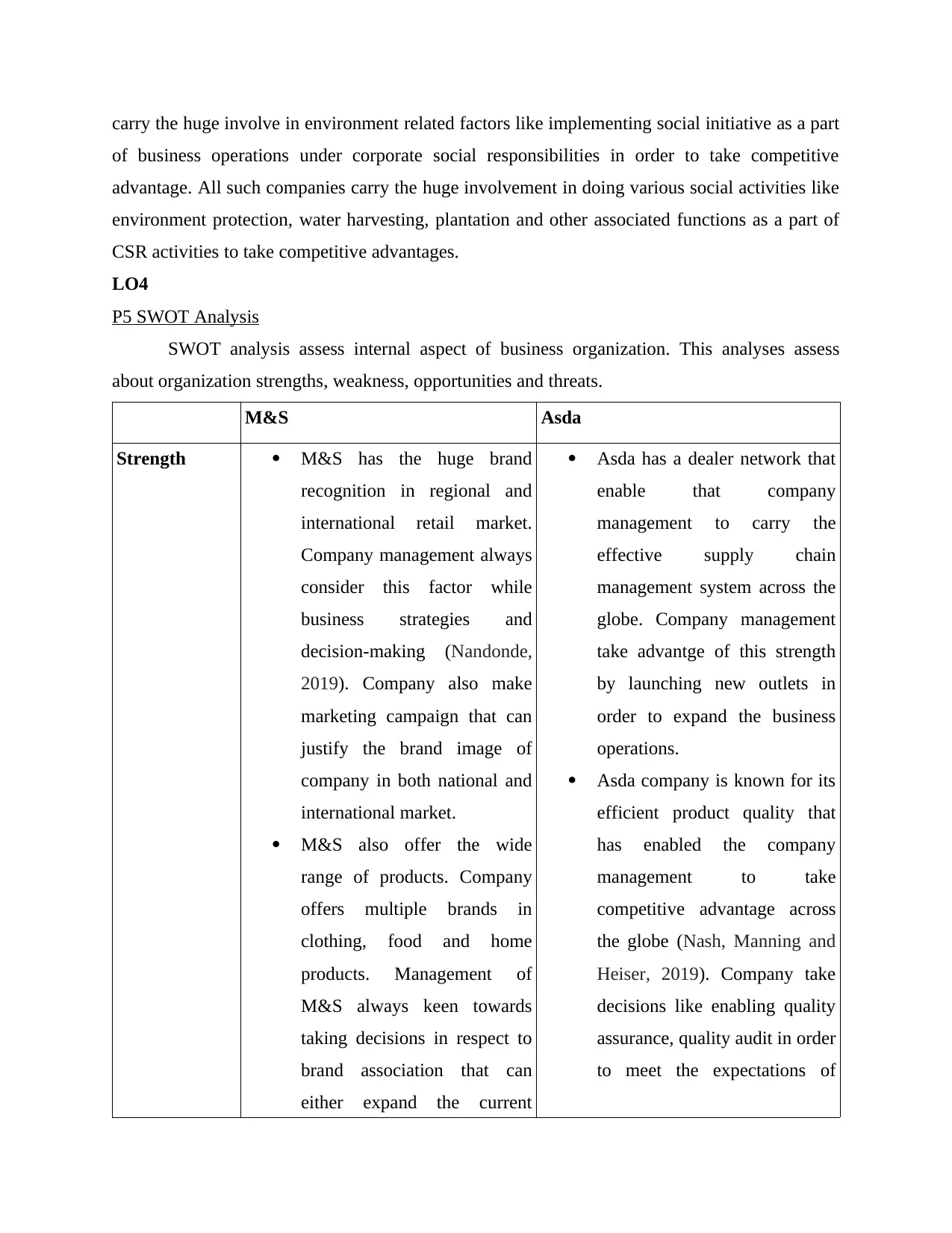
carry the huge involve in environment related factors like implementing social initiative as a part
of business operations under corporate social responsibilities in order to take competitive
advantage. All such companies carry the huge involvement in doing various social activities like
environment protection, water harvesting, plantation and other associated functions as a part of
CSR activities to take competitive advantages.
LO4
P5 SWOT Analysis
SWOT analysis assess internal aspect of business organization. This analyses assess
about organization strengths, weakness, opportunities and threats.
M&S Asda
Strength M&S has the huge brand
recognition in regional and
international retail market.
Company management always
consider this factor while
business strategies and
decision-making (Nandonde,
2019). Company also make
marketing campaign that can
justify the brand image of
company in both national and
international market.
M&S also offer the wide
range of products. Company
offers multiple brands in
clothing, food and home
products. Management of
M&S always keen towards
taking decisions in respect to
brand association that can
either expand the current
Asda has a dealer network that
enable that company
management to carry the
effective supply chain
management system across the
globe. Company management
take advantge of this strength
by launching new outlets in
order to expand the business
operations.
Asda company is known for its
efficient product quality that
has enabled the company
management to take
competitive advantage across
the globe (Nash, Manning and
Heiser, 2019). Company take
decisions like enabling quality
assurance, quality audit in order
to meet the expectations of
of business operations under corporate social responsibilities in order to take competitive
advantage. All such companies carry the huge involvement in doing various social activities like
environment protection, water harvesting, plantation and other associated functions as a part of
CSR activities to take competitive advantages.
LO4
P5 SWOT Analysis
SWOT analysis assess internal aspect of business organization. This analyses assess
about organization strengths, weakness, opportunities and threats.
M&S Asda
Strength M&S has the huge brand
recognition in regional and
international retail market.
Company management always
consider this factor while
business strategies and
decision-making (Nandonde,
2019). Company also make
marketing campaign that can
justify the brand image of
company in both national and
international market.
M&S also offer the wide
range of products. Company
offers multiple brands in
clothing, food and home
products. Management of
M&S always keen towards
taking decisions in respect to
brand association that can
either expand the current
Asda has a dealer network that
enable that company
management to carry the
effective supply chain
management system across the
globe. Company management
take advantge of this strength
by launching new outlets in
order to expand the business
operations.
Asda company is known for its
efficient product quality that
has enabled the company
management to take
competitive advantage across
the globe (Nash, Manning and
Heiser, 2019). Company take
decisions like enabling quality
assurance, quality audit in order
to meet the expectations of

product line or can enable the
company management to offer
the new product.
M&S also has many stores
across the globe. Company is
offering its services in more
than 1400 locations that has
provided a huge target
customer base for company's
operations. Company always
take decisions to utilize the
huge target customer base and
store line by launching new
products and brands to expand
the profitability.
target customer's.
Asda has a strong brand
portfolio that has supported
company management to
generate effective profitability
across the globe. Company
management take decisions like
using brand management
strategical tool to improve the
brand presence in the retail
market.
Weaknesses M&S is known as a brand of
non trendy products. Company
management could not cope
up with the expectations of the
target customer's with its
current product line. Company
management consider this
weakness in taking decisions
like product launch but still
not meet up the expectations
of target customer's.
M&S is also known for its
costly products. Company
offers products at higer prices
as compare to other
competitors in order to
Asda is not efficient in
intigrating with different firms
in respect to different work
culture. Company management
take decisions like recruitment
decisions to improve its
organisation culture by making
it more dynamic but still
company management is not
able to cope up with work
culture of other associated
companies.
Asda is not keen in respect to
technology advancement and
development that also restricted
company's presence in the
company management to offer
the new product.
M&S also has many stores
across the globe. Company is
offering its services in more
than 1400 locations that has
provided a huge target
customer base for company's
operations. Company always
take decisions to utilize the
huge target customer base and
store line by launching new
products and brands to expand
the profitability.
target customer's.
Asda has a strong brand
portfolio that has supported
company management to
generate effective profitability
across the globe. Company
management take decisions like
using brand management
strategical tool to improve the
brand presence in the retail
market.
Weaknesses M&S is known as a brand of
non trendy products. Company
management could not cope
up with the expectations of the
target customer's with its
current product line. Company
management consider this
weakness in taking decisions
like product launch but still
not meet up the expectations
of target customer's.
M&S is also known for its
costly products. Company
offers products at higer prices
as compare to other
competitors in order to
Asda is not efficient in
intigrating with different firms
in respect to different work
culture. Company management
take decisions like recruitment
decisions to improve its
organisation culture by making
it more dynamic but still
company management is not
able to cope up with work
culture of other associated
companies.
Asda is not keen in respect to
technology advancement and
development that also restricted
company's presence in the
Secure Best Marks with AI Grader
Need help grading? Try our AI Grader for instant feedback on your assignments.
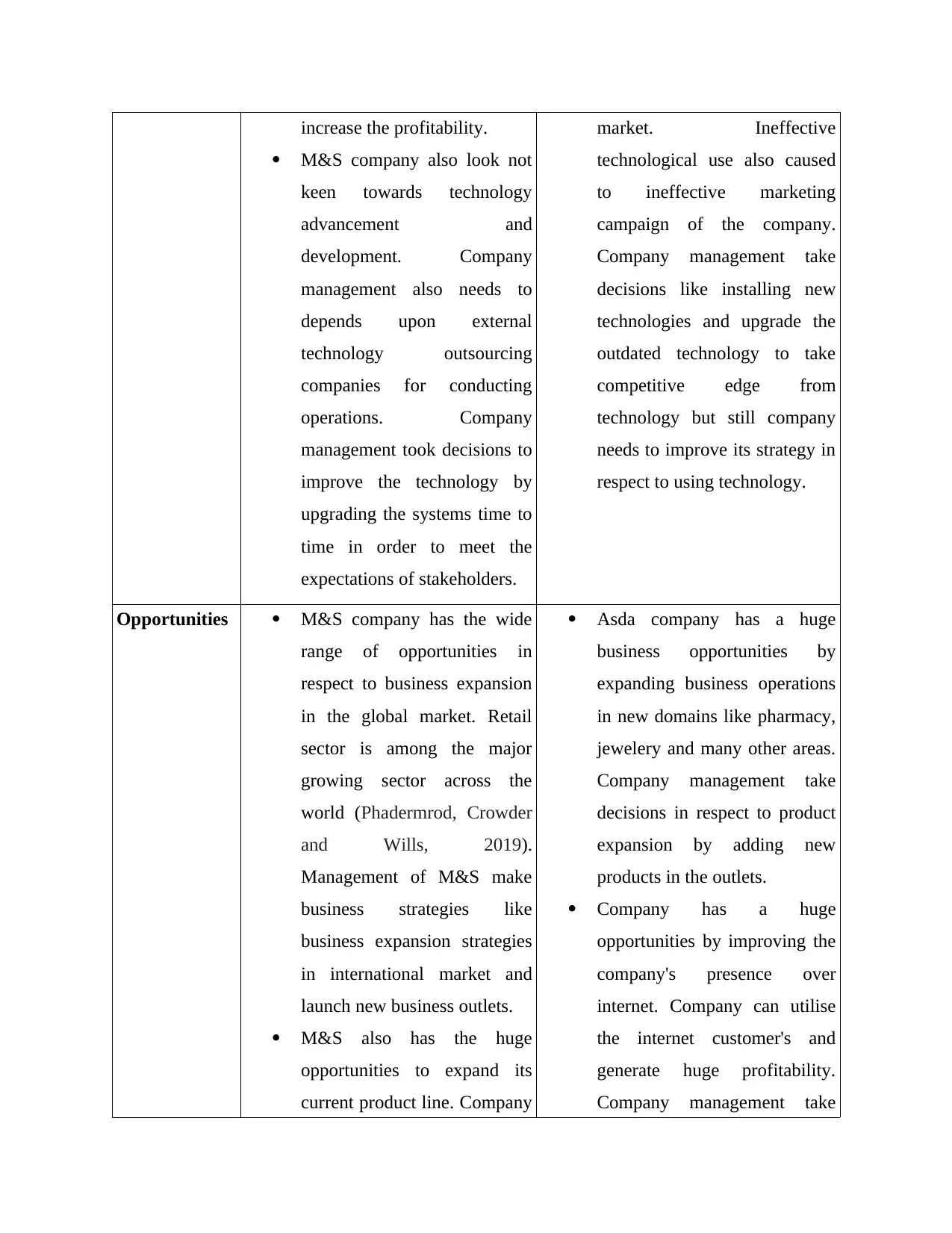
increase the profitability.
M&S company also look not
keen towards technology
advancement and
development. Company
management also needs to
depends upon external
technology outsourcing
companies for conducting
operations. Company
management took decisions to
improve the technology by
upgrading the systems time to
time in order to meet the
expectations of stakeholders.
market. Ineffective
technological use also caused
to ineffective marketing
campaign of the company.
Company management take
decisions like installing new
technologies and upgrade the
outdated technology to take
competitive edge from
technology but still company
needs to improve its strategy in
respect to using technology.
Opportunities M&S company has the wide
range of opportunities in
respect to business expansion
in the global market. Retail
sector is among the major
growing sector across the
world (Phadermrod, Crowder
and Wills, 2019).
Management of M&S make
business strategies like
business expansion strategies
in international market and
launch new business outlets.
M&S also has the huge
opportunities to expand its
current product line. Company
Asda company has a huge
business opportunities by
expanding business operations
in new domains like pharmacy,
jewelery and many other areas.
Company management take
decisions in respect to product
expansion by adding new
products in the outlets.
Company has a huge
opportunities by improving the
company's presence over
internet. Company can utilise
the internet customer's and
generate huge profitability.
Company management take
M&S company also look not
keen towards technology
advancement and
development. Company
management also needs to
depends upon external
technology outsourcing
companies for conducting
operations. Company
management took decisions to
improve the technology by
upgrading the systems time to
time in order to meet the
expectations of stakeholders.
market. Ineffective
technological use also caused
to ineffective marketing
campaign of the company.
Company management take
decisions like installing new
technologies and upgrade the
outdated technology to take
competitive edge from
technology but still company
needs to improve its strategy in
respect to using technology.
Opportunities M&S company has the wide
range of opportunities in
respect to business expansion
in the global market. Retail
sector is among the major
growing sector across the
world (Phadermrod, Crowder
and Wills, 2019).
Management of M&S make
business strategies like
business expansion strategies
in international market and
launch new business outlets.
M&S also has the huge
opportunities to expand its
current product line. Company
Asda company has a huge
business opportunities by
expanding business operations
in new domains like pharmacy,
jewelery and many other areas.
Company management take
decisions in respect to product
expansion by adding new
products in the outlets.
Company has a huge
opportunities by improving the
company's presence over
internet. Company can utilise
the internet customer's and
generate huge profitability.
Company management take
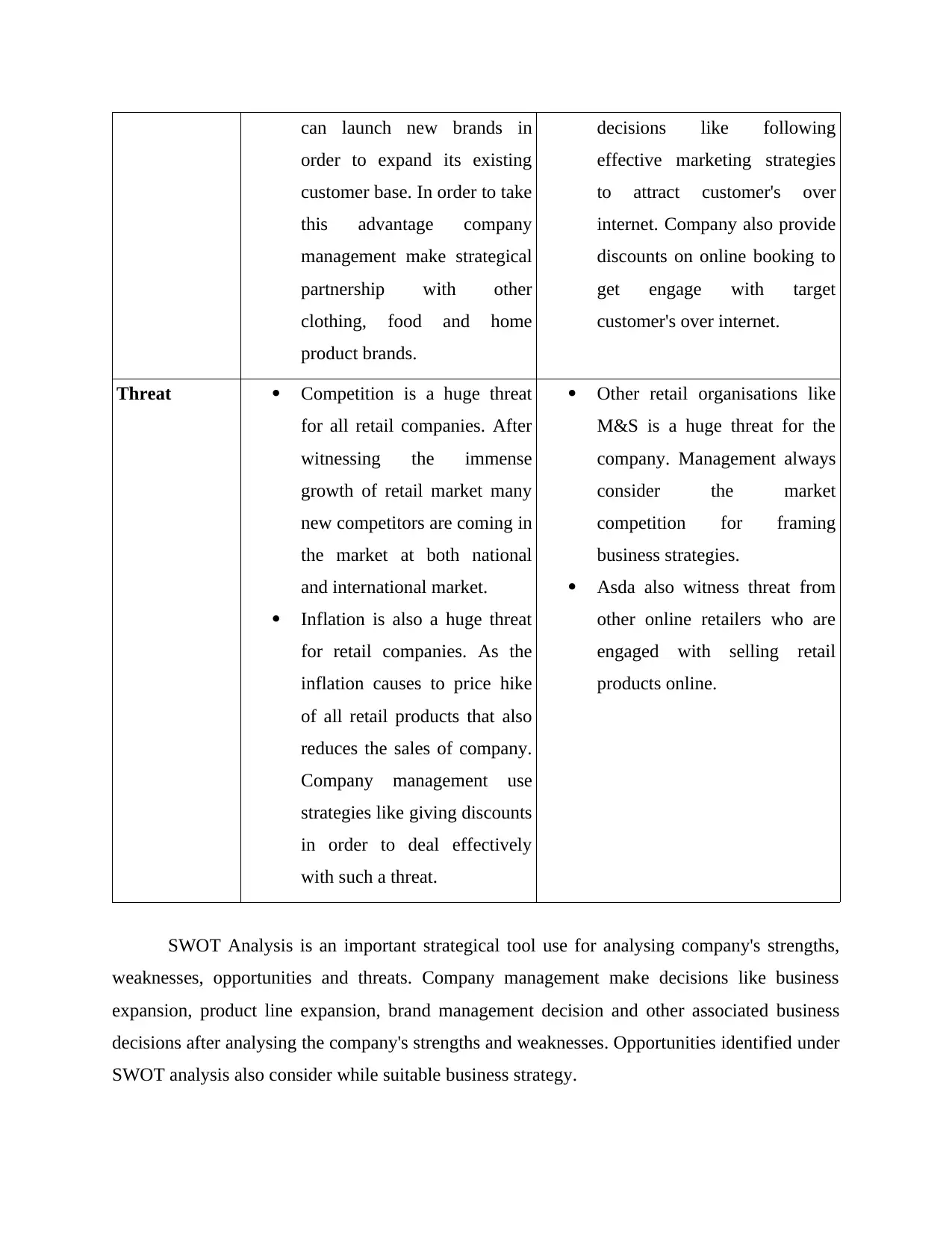
can launch new brands in
order to expand its existing
customer base. In order to take
this advantage company
management make strategical
partnership with other
clothing, food and home
product brands.
decisions like following
effective marketing strategies
to attract customer's over
internet. Company also provide
discounts on online booking to
get engage with target
customer's over internet.
Threat Competition is a huge threat
for all retail companies. After
witnessing the immense
growth of retail market many
new competitors are coming in
the market at both national
and international market.
Inflation is also a huge threat
for retail companies. As the
inflation causes to price hike
of all retail products that also
reduces the sales of company.
Company management use
strategies like giving discounts
in order to deal effectively
with such a threat.
Other retail organisations like
M&S is a huge threat for the
company. Management always
consider the market
competition for framing
business strategies.
Asda also witness threat from
other online retailers who are
engaged with selling retail
products online.
SWOT Analysis is an important strategical tool use for analysing company's strengths,
weaknesses, opportunities and threats. Company management make decisions like business
expansion, product line expansion, brand management decision and other associated business
decisions after analysing the company's strengths and weaknesses. Opportunities identified under
SWOT analysis also consider while suitable business strategy.
order to expand its existing
customer base. In order to take
this advantage company
management make strategical
partnership with other
clothing, food and home
product brands.
decisions like following
effective marketing strategies
to attract customer's over
internet. Company also provide
discounts on online booking to
get engage with target
customer's over internet.
Threat Competition is a huge threat
for all retail companies. After
witnessing the immense
growth of retail market many
new competitors are coming in
the market at both national
and international market.
Inflation is also a huge threat
for retail companies. As the
inflation causes to price hike
of all retail products that also
reduces the sales of company.
Company management use
strategies like giving discounts
in order to deal effectively
with such a threat.
Other retail organisations like
M&S is a huge threat for the
company. Management always
consider the market
competition for framing
business strategies.
Asda also witness threat from
other online retailers who are
engaged with selling retail
products online.
SWOT Analysis is an important strategical tool use for analysing company's strengths,
weaknesses, opportunities and threats. Company management make decisions like business
expansion, product line expansion, brand management decision and other associated business
decisions after analysing the company's strengths and weaknesses. Opportunities identified under
SWOT analysis also consider while suitable business strategy.
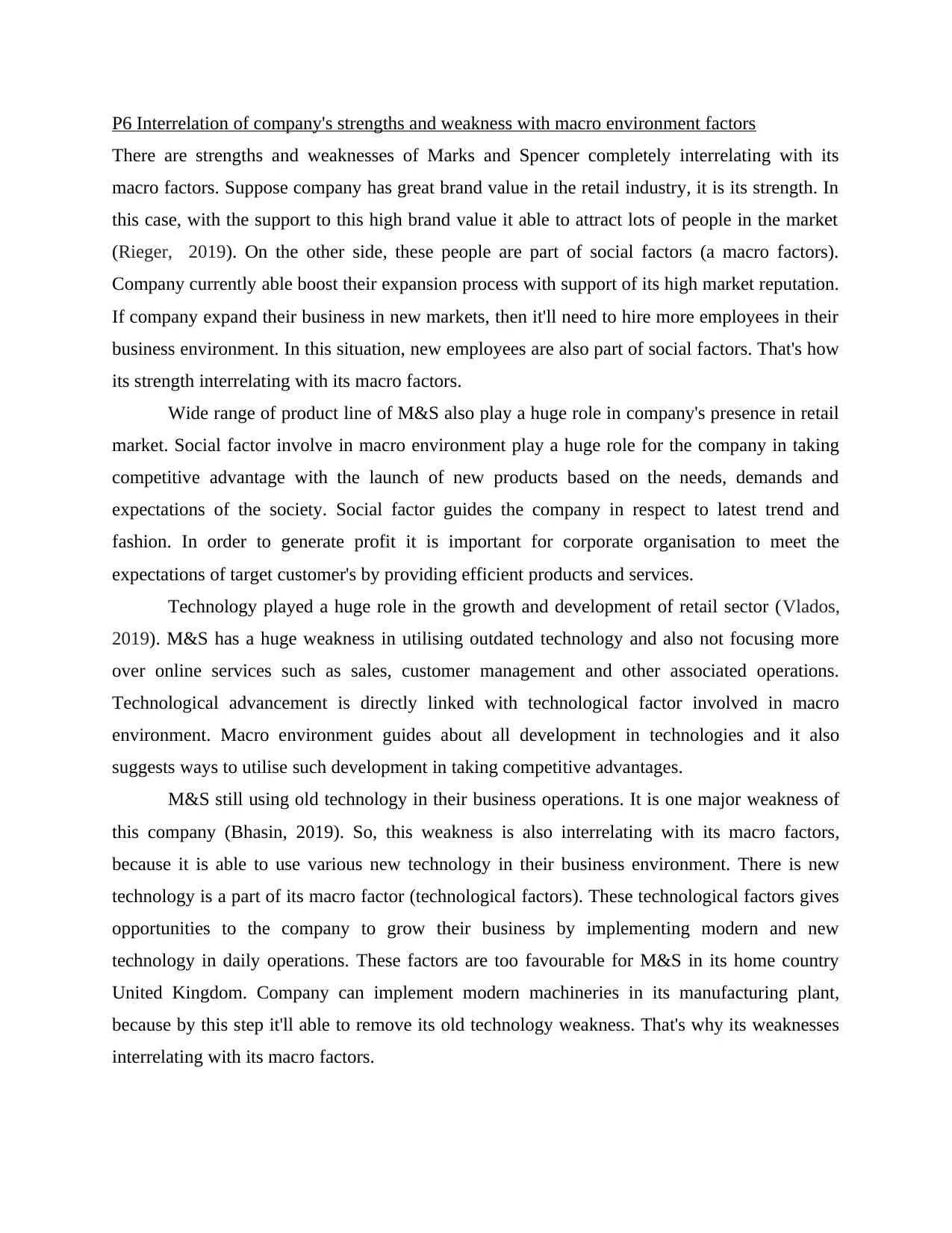
P6 Interrelation of company's strengths and weakness with macro environment factors
There are strengths and weaknesses of Marks and Spencer completely interrelating with its
macro factors. Suppose company has great brand value in the retail industry, it is its strength. In
this case, with the support to this high brand value it able to attract lots of people in the market
(Rieger, 2019). On the other side, these people are part of social factors (a macro factors).
Company currently able boost their expansion process with support of its high market reputation.
If company expand their business in new markets, then it'll need to hire more employees in their
business environment. In this situation, new employees are also part of social factors. That's how
its strength interrelating with its macro factors.
Wide range of product line of M&S also play a huge role in company's presence in retail
market. Social factor involve in macro environment play a huge role for the company in taking
competitive advantage with the launch of new products based on the needs, demands and
expectations of the society. Social factor guides the company in respect to latest trend and
fashion. In order to generate profit it is important for corporate organisation to meet the
expectations of target customer's by providing efficient products and services.
Technology played a huge role in the growth and development of retail sector (Vlados,
2019). M&S has a huge weakness in utilising outdated technology and also not focusing more
over online services such as sales, customer management and other associated operations.
Technological advancement is directly linked with technological factor involved in macro
environment. Macro environment guides about all development in technologies and it also
suggests ways to utilise such development in taking competitive advantages.
M&S still using old technology in their business operations. It is one major weakness of
this company (Bhasin, 2019). So, this weakness is also interrelating with its macro factors,
because it is able to use various new technology in their business environment. There is new
technology is a part of its macro factor (technological factors). These technological factors gives
opportunities to the company to grow their business by implementing modern and new
technology in daily operations. These factors are too favourable for M&S in its home country
United Kingdom. Company can implement modern machineries in its manufacturing plant,
because by this step it'll able to remove its old technology weakness. That's why its weaknesses
interrelating with its macro factors.
There are strengths and weaknesses of Marks and Spencer completely interrelating with its
macro factors. Suppose company has great brand value in the retail industry, it is its strength. In
this case, with the support to this high brand value it able to attract lots of people in the market
(Rieger, 2019). On the other side, these people are part of social factors (a macro factors).
Company currently able boost their expansion process with support of its high market reputation.
If company expand their business in new markets, then it'll need to hire more employees in their
business environment. In this situation, new employees are also part of social factors. That's how
its strength interrelating with its macro factors.
Wide range of product line of M&S also play a huge role in company's presence in retail
market. Social factor involve in macro environment play a huge role for the company in taking
competitive advantage with the launch of new products based on the needs, demands and
expectations of the society. Social factor guides the company in respect to latest trend and
fashion. In order to generate profit it is important for corporate organisation to meet the
expectations of target customer's by providing efficient products and services.
Technology played a huge role in the growth and development of retail sector (Vlados,
2019). M&S has a huge weakness in utilising outdated technology and also not focusing more
over online services such as sales, customer management and other associated operations.
Technological advancement is directly linked with technological factor involved in macro
environment. Macro environment guides about all development in technologies and it also
suggests ways to utilise such development in taking competitive advantages.
M&S still using old technology in their business operations. It is one major weakness of
this company (Bhasin, 2019). So, this weakness is also interrelating with its macro factors,
because it is able to use various new technology in their business environment. There is new
technology is a part of its macro factor (technological factors). These technological factors gives
opportunities to the company to grow their business by implementing modern and new
technology in daily operations. These factors are too favourable for M&S in its home country
United Kingdom. Company can implement modern machineries in its manufacturing plant,
because by this step it'll able to remove its old technology weakness. That's why its weaknesses
interrelating with its macro factors.
Paraphrase This Document
Need a fresh take? Get an instant paraphrase of this document with our AI Paraphraser

CONCLUSION
It can be concluded from above report that public, private and voluntary sectors have
different types of objective, purpose and legal structure. Organization structure, size and scope
of operation is related to business objectives and product and services offered by company. Each
department play a crucial role in growth and success of business. It can be also been explained
from above analyses that interrelation between finance, marketing, human other department is
necessary for achievement of goals. External macro environmental factors helps company in
gaining competitive advantages and enhancing profitability of company. SWOT Analysis helps
in identifying strength and weakness of company thus protect it from various threats and
opportunities of that are present in market. Thus, it can be concluded that analysis of various
internal and external factor of environment helps in growth and success of business.
It can be concluded from above report that public, private and voluntary sectors have
different types of objective, purpose and legal structure. Organization structure, size and scope
of operation is related to business objectives and product and services offered by company. Each
department play a crucial role in growth and success of business. It can be also been explained
from above analyses that interrelation between finance, marketing, human other department is
necessary for achievement of goals. External macro environmental factors helps company in
gaining competitive advantages and enhancing profitability of company. SWOT Analysis helps
in identifying strength and weakness of company thus protect it from various threats and
opportunities of that are present in market. Thus, it can be concluded that analysis of various
internal and external factor of environment helps in growth and success of business.
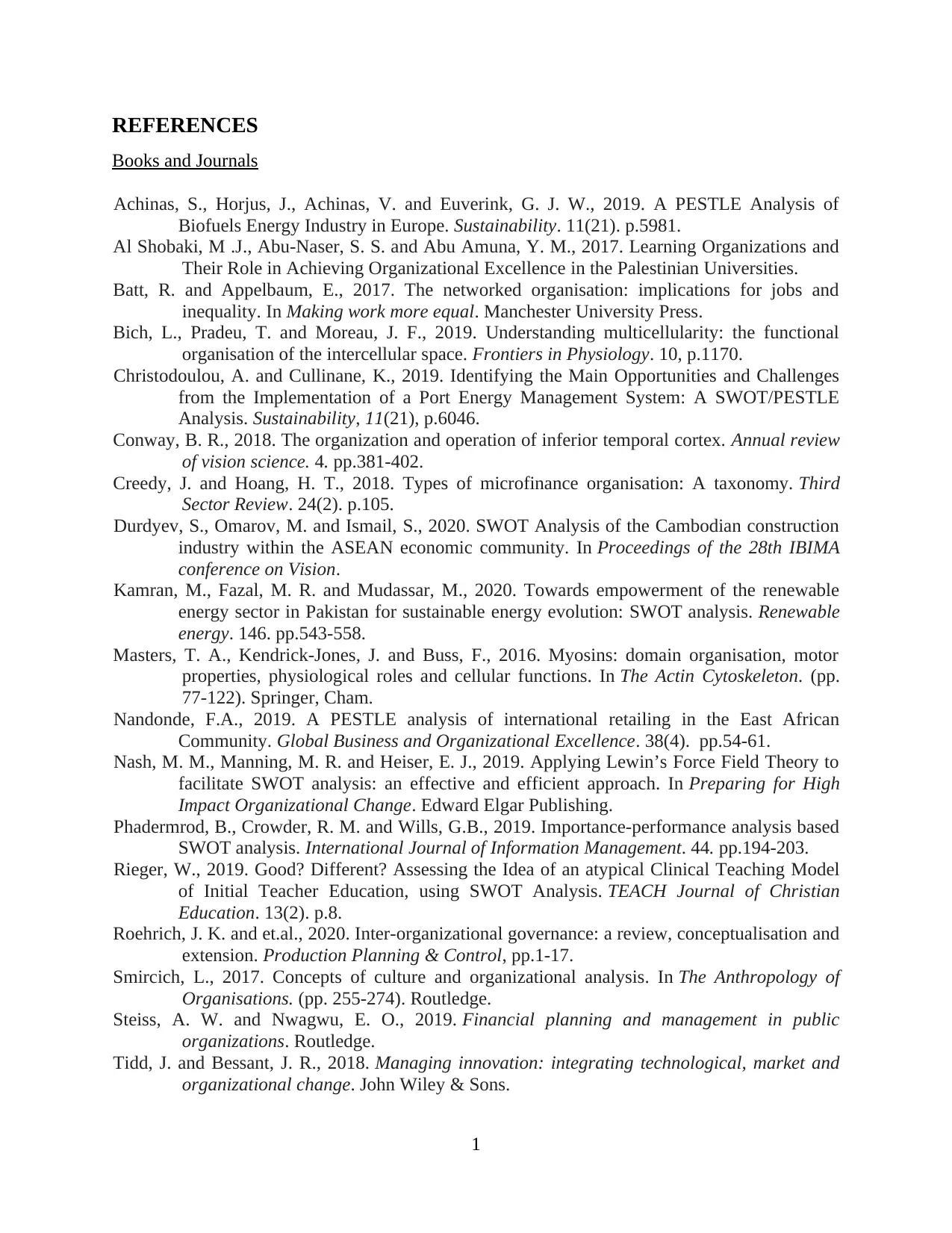
REFERENCES
Books and Journals
Achinas, S., Horjus, J., Achinas, V. and Euverink, G. J. W., 2019. A PESTLE Analysis of
Biofuels Energy Industry in Europe. Sustainability. 11(21). p.5981.
Al Shobaki, M .J., Abu-Naser, S. S. and Abu Amuna, Y. M., 2017. Learning Organizations and
Their Role in Achieving Organizational Excellence in the Palestinian Universities.
Batt, R. and Appelbaum, E., 2017. The networked organisation: implications for jobs and
inequality. In Making work more equal. Manchester University Press.
Bich, L., Pradeu, T. and Moreau, J. F., 2019. Understanding multicellularity: the functional
organisation of the intercellular space. Frontiers in Physiology. 10, p.1170.
Christodoulou, A. and Cullinane, K., 2019. Identifying the Main Opportunities and Challenges
from the Implementation of a Port Energy Management System: A SWOT/PESTLE
Analysis. Sustainability, 11(21), p.6046.
Conway, B. R., 2018. The organization and operation of inferior temporal cortex. Annual review
of vision science. 4. pp.381-402.
Creedy, J. and Hoang, H. T., 2018. Types of microfinance organisation: A taxonomy. Third
Sector Review. 24(2). p.105.
Durdyev, S., Omarov, M. and Ismail, S., 2020. SWOT Analysis of the Cambodian construction
industry within the ASEAN economic community. In Proceedings of the 28th IBIMA
conference on Vision.
Kamran, M., Fazal, M. R. and Mudassar, M., 2020. Towards empowerment of the renewable
energy sector in Pakistan for sustainable energy evolution: SWOT analysis. Renewable
energy. 146. pp.543-558.
Masters, T. A., Kendrick-Jones, J. and Buss, F., 2016. Myosins: domain organisation, motor
properties, physiological roles and cellular functions. In The Actin Cytoskeleton. (pp.
77-122). Springer, Cham.
Nandonde, F.A., 2019. A PESTLE analysis of international retailing in the East African
Community. Global Business and Organizational Excellence. 38(4). pp.54-61.
Nash, M. M., Manning, M. R. and Heiser, E. J., 2019. Applying Lewin’s Force Field Theory to
facilitate SWOT analysis: an effective and efficient approach. In Preparing for High
Impact Organizational Change. Edward Elgar Publishing.
Phadermrod, B., Crowder, R. M. and Wills, G.B., 2019. Importance-performance analysis based
SWOT analysis. International Journal of Information Management. 44. pp.194-203.
Rieger, W., 2019. Good? Different? Assessing the Idea of an atypical Clinical Teaching Model
of Initial Teacher Education, using SWOT Analysis. TEACH Journal of Christian
Education. 13(2). p.8.
Roehrich, J. K. and et.al., 2020. Inter-organizational governance: a review, conceptualisation and
extension. Production Planning & Control, pp.1-17.
Smircich, L., 2017. Concepts of culture and organizational analysis. In The Anthropology of
Organisations. (pp. 255-274). Routledge.
Steiss, A. W. and Nwagwu, E. O., 2019. Financial planning and management in public
organizations. Routledge.
Tidd, J. and Bessant, J. R., 2018. Managing innovation: integrating technological, market and
organizational change. John Wiley & Sons.
1
Books and Journals
Achinas, S., Horjus, J., Achinas, V. and Euverink, G. J. W., 2019. A PESTLE Analysis of
Biofuels Energy Industry in Europe. Sustainability. 11(21). p.5981.
Al Shobaki, M .J., Abu-Naser, S. S. and Abu Amuna, Y. M., 2017. Learning Organizations and
Their Role in Achieving Organizational Excellence in the Palestinian Universities.
Batt, R. and Appelbaum, E., 2017. The networked organisation: implications for jobs and
inequality. In Making work more equal. Manchester University Press.
Bich, L., Pradeu, T. and Moreau, J. F., 2019. Understanding multicellularity: the functional
organisation of the intercellular space. Frontiers in Physiology. 10, p.1170.
Christodoulou, A. and Cullinane, K., 2019. Identifying the Main Opportunities and Challenges
from the Implementation of a Port Energy Management System: A SWOT/PESTLE
Analysis. Sustainability, 11(21), p.6046.
Conway, B. R., 2018. The organization and operation of inferior temporal cortex. Annual review
of vision science. 4. pp.381-402.
Creedy, J. and Hoang, H. T., 2018. Types of microfinance organisation: A taxonomy. Third
Sector Review. 24(2). p.105.
Durdyev, S., Omarov, M. and Ismail, S., 2020. SWOT Analysis of the Cambodian construction
industry within the ASEAN economic community. In Proceedings of the 28th IBIMA
conference on Vision.
Kamran, M., Fazal, M. R. and Mudassar, M., 2020. Towards empowerment of the renewable
energy sector in Pakistan for sustainable energy evolution: SWOT analysis. Renewable
energy. 146. pp.543-558.
Masters, T. A., Kendrick-Jones, J. and Buss, F., 2016. Myosins: domain organisation, motor
properties, physiological roles and cellular functions. In The Actin Cytoskeleton. (pp.
77-122). Springer, Cham.
Nandonde, F.A., 2019. A PESTLE analysis of international retailing in the East African
Community. Global Business and Organizational Excellence. 38(4). pp.54-61.
Nash, M. M., Manning, M. R. and Heiser, E. J., 2019. Applying Lewin’s Force Field Theory to
facilitate SWOT analysis: an effective and efficient approach. In Preparing for High
Impact Organizational Change. Edward Elgar Publishing.
Phadermrod, B., Crowder, R. M. and Wills, G.B., 2019. Importance-performance analysis based
SWOT analysis. International Journal of Information Management. 44. pp.194-203.
Rieger, W., 2019. Good? Different? Assessing the Idea of an atypical Clinical Teaching Model
of Initial Teacher Education, using SWOT Analysis. TEACH Journal of Christian
Education. 13(2). p.8.
Roehrich, J. K. and et.al., 2020. Inter-organizational governance: a review, conceptualisation and
extension. Production Planning & Control, pp.1-17.
Smircich, L., 2017. Concepts of culture and organizational analysis. In The Anthropology of
Organisations. (pp. 255-274). Routledge.
Steiss, A. W. and Nwagwu, E. O., 2019. Financial planning and management in public
organizations. Routledge.
Tidd, J. and Bessant, J. R., 2018. Managing innovation: integrating technological, market and
organizational change. John Wiley & Sons.
1
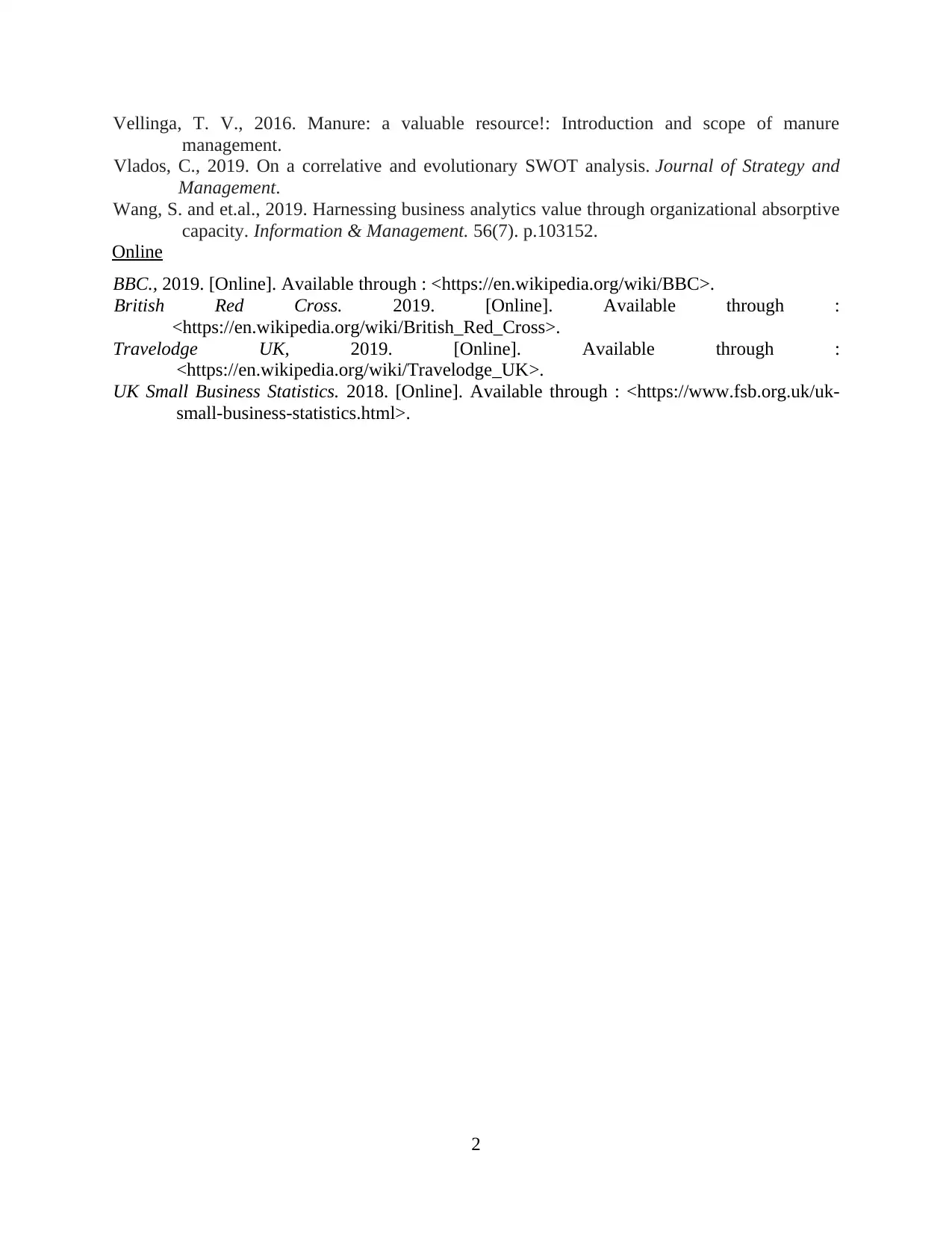
Vellinga, T. V., 2016. Manure: a valuable resource!: Introduction and scope of manure
management.
Vlados, C., 2019. On a correlative and evolutionary SWOT analysis. Journal of Strategy and
Management.
Wang, S. and et.al., 2019. Harnessing business analytics value through organizational absorptive
capacity. Information & Management. 56(7). p.103152.
Online
BBC., 2019. [Online]. Available through : <https://en.wikipedia.org/wiki/BBC>.
British Red Cross. 2019. [Online]. Available through :
<https://en.wikipedia.org/wiki/British_Red_Cross>.
Travelodge UK, 2019. [Online]. Available through :
<https://en.wikipedia.org/wiki/Travelodge_UK>.
UK Small Business Statistics. 2018. [Online]. Available through : <https://www.fsb.org.uk/uk-
small-business-statistics.html>.
2
management.
Vlados, C., 2019. On a correlative and evolutionary SWOT analysis. Journal of Strategy and
Management.
Wang, S. and et.al., 2019. Harnessing business analytics value through organizational absorptive
capacity. Information & Management. 56(7). p.103152.
Online
BBC., 2019. [Online]. Available through : <https://en.wikipedia.org/wiki/BBC>.
British Red Cross. 2019. [Online]. Available through :
<https://en.wikipedia.org/wiki/British_Red_Cross>.
Travelodge UK, 2019. [Online]. Available through :
<https://en.wikipedia.org/wiki/Travelodge_UK>.
UK Small Business Statistics. 2018. [Online]. Available through : <https://www.fsb.org.uk/uk-
small-business-statistics.html>.
2
Secure Best Marks with AI Grader
Need help grading? Try our AI Grader for instant feedback on your assignments.

3
1 out of 20
![[object Object]](/_next/static/media/star-bottom.7253800d.svg)





